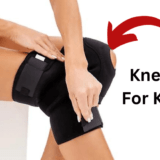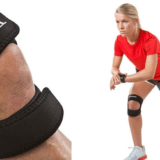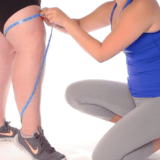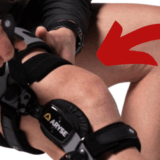15 Best Knee Brace For Knee Pain Relief in 2024
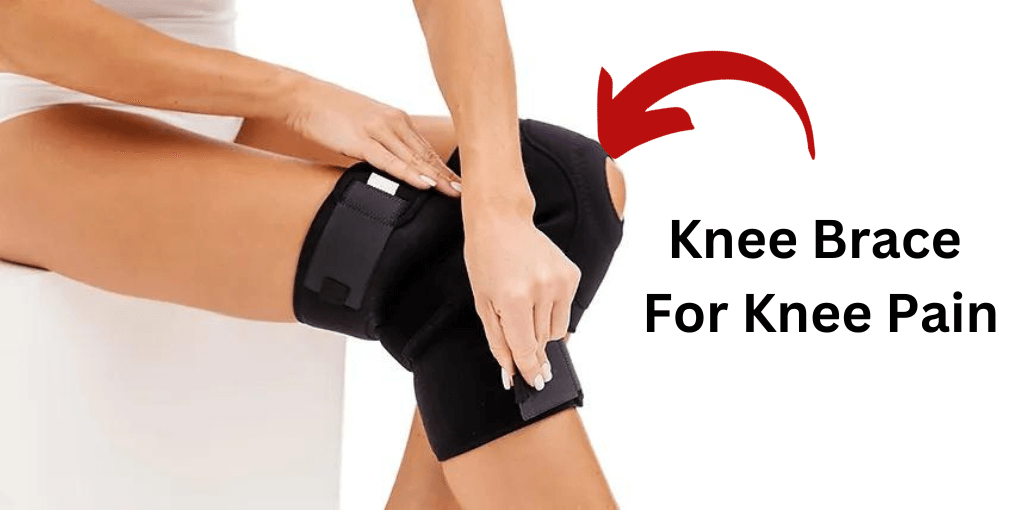
Are you looking for the best knee brace and support to provide relief and stability? Look no further! Knee pain is a common problem that can affect people of all ages and activity levels.
Various factors, like injuries, overuse, and arthritis, can cause it. If you’re experiencing knee pain, a knee brace can help to provide support and stability. It can reduce pain and improve function.
It serves as a critical tool that supports and protects your knee joint. It aids in injury prevention, reducing discomfort, and facilitating the healing process.
With a wide array of knee braces available on the market, each designed for specific purposes. It can be overwhelming to determine which one suits your unique needs best.
There are many different types of knee braces available. It’s important to choose the right one for your needs.
Think about your injury, how active you are, and your budget when choosing a knee brace.
In this blog post, we’ll review the best knee braces on the market for a variety of needs and budgets.
We’ll also provide tips on how to choose the right knee brace for you and how to wear it properly. Let’s dive in and find the perfect solution for you!
What is a knee brace?
A knee brace is a medical or orthopedic device. It helps to provide support, stability, and protection to the knee joint.
People wear this device to help safeguard their knees. You can use it to reduce pain, keep steady, and stop injuries.
Knee braces come in various sizes. These sizes include fabric, neoprene, metal, plastic, and elastic materials. It styles to fit the individual needs of the wearer. You can use it for:
- Reduce pain and inflammation
- Improve stability and support
- Prevent further injury
- Promote proper healing
- Increase range of motion
- Return to normal activities more quickly
15 Best Knee Brace Review in 2024
If you’re looking for a review of the best knee braces available, it’s essential to consider your specific needs and the type of support you require.
However, I can provide a general overview of some well-regarded knee braces that have received positive reviews in the past.
Please note that the availability and popularity of knee braces may change over time, so it’s a good idea to check for the latest reviews and ratings when making your decision.
1. IPOW 2 Pack Patella Stabilizer Knee Strap Brace
The IPOW 2 Pack Knee Pain Relief & Patella Stabilizer Knee Strap Brace is a popular orthopedic solution designed to provide effective support, pain relief, and stability for individuals dealing with knee discomfort and patellar-related issues.
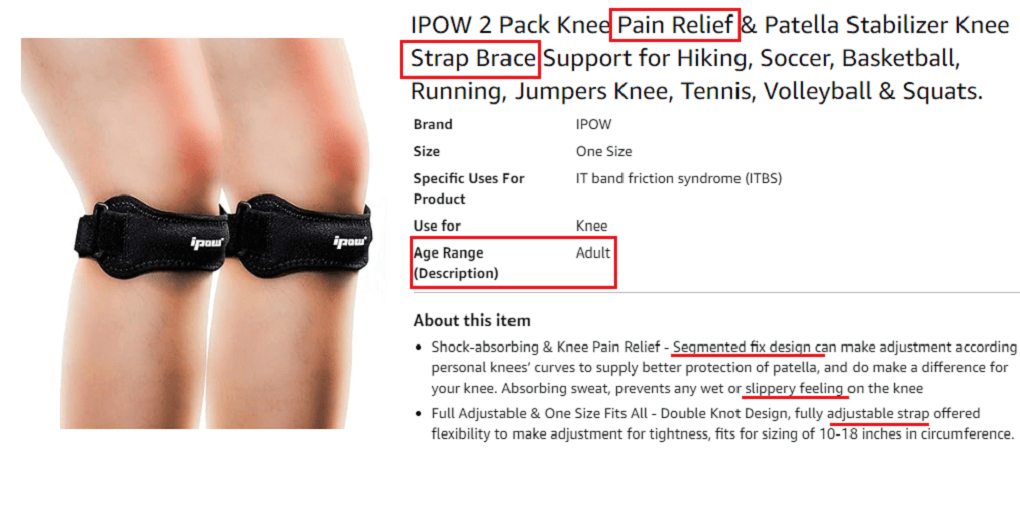
These knee straps are known for their simplicity, comfort, and versatility, making them a preferred choice for those seeking a practical solution to alleviate knee pain.
Key Benefits
- Designed to stabilize the patella (kneecap), reducing the risk of patellar dislocation and promoting proper alignment
- Customizable compression and support with adjustable straps featuring hook-and-loop closures
- Lightweight and slim profile that can be discreetly worn under clothing without feeling bulky
- Constructed with breathable and moisture-wicking materials to keep the knee dry and comfortable during extended wear
- Inner lining includes anti-slip silicone grips to prevent slippage during physical activities
- Suitable for sports, workouts, daily wear, and post-injury rehabilitation, accommodating various lifestyles and knee conditions
- Available in a unisex design and various sizes to accommodate users of different body types
- Putting on and adjusting the straps is a straightforward process, making them convenient for daily use or during physical activities
- Despite their slim design, these knee straps are made from durable materials designed to withstand regular wear and tear
- The simple yet effective design focuses on patellar stabilization without unnecessary bulk or complexity
- The product includes two knee straps in one pack, offering users the option to use them on both knees or keep one as a spare
- The knee straps provide cost-effective knee support, making them accessible to a wide range of users
User Experience
The IPOW 2 Pack Knee Pain Relief & Patella Stabilizer Knee Strap Brace was recently available for me to test out.
I was looking forward to finding a knee strap brace that might provide the support and comfort I required because I had experienced persistent knee pain.
The brace itself is made of durable and lightweight materials, ensuring longevity and comfort.
The adjustable straps allowed me to find the perfect fit, providing a secure and snug feel around my knees.
The velcro closures made it easy to put on and take off, while ensuring a secure hold throughout various activities.
The patella stabilizer design effectively reduces the pressure on the kneecap, providing much-needed support for individuals suffering from conditions such as patellar tendinitis or runner’s knee.
The adjustable straps allow for personalized compression, which promotes better blood flow and assists in reducing swelling and inflammation.
Comfort was another area where the IPOW Knee Strap Brace excelled. The soft padding underneath the brace prevented any irritation or discomfort against my skin, even during extended wear.
The breathable material allowed for proper ventilation, preventing sweat build-up and ensuring a cool and comfortable experience, even during workouts or other physical activities.
Reasons To Like
- Adjustable Compression
- Slim and Discreet Design
- Affordability
- Versatile Use
Reasons to Avoid
- Limited Support for Other Knee Issues
- Potential Slippage
2. Mueller Sports Medicine Self-Adjusting Knee Brace
Mueller Sports Medicine is a brand known for its commitment to enhancing athletic performance and aiding in the recovery process. One of their standout products in this endeavor is the “Mueller Sports Medicine Self-Adjusting Adult Knee Support Braces.”
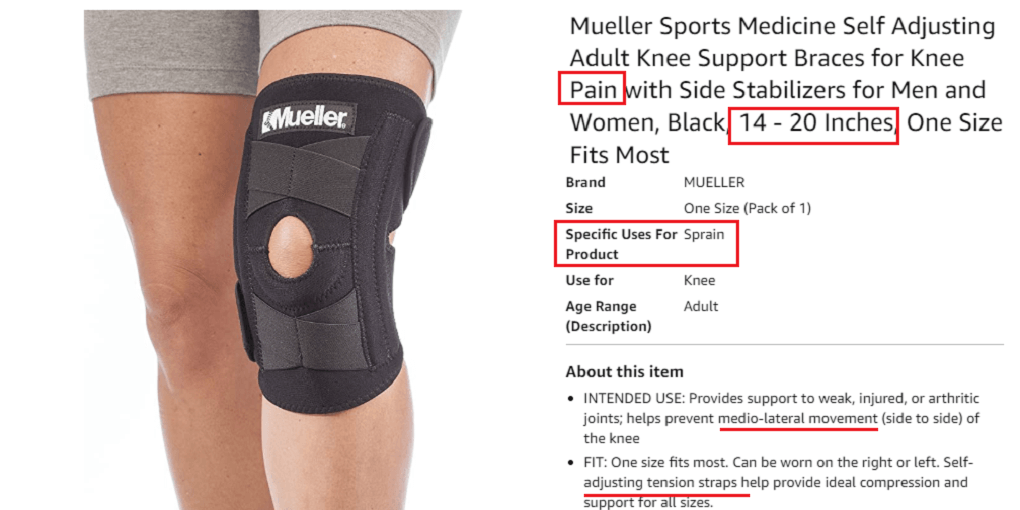
These braces offer a unique combination of support, comfort, and adaptability, making them a popular choice among athletes and individuals seeking knee support and stability.
Key Benefits
- Automatically conforms to the shape and contours of the knee for a personalized and secure fit
- Provides reliable support to stabilize the knee joint during physical activities and reduce the risk of injury
- Made from breathable and lightweight materials, ensuring extended comfort without excessive sweating
- Offers compression for improved blood flow, reduced swelling, and heat retention for pain relief and muscle recovery
- Suitable for a wide range of activities, from sports and exercise to everyday tasks
- Customizable straps allow users to achieve the desired level of compression and support
- Designed to fit adults, making it suitable for both men and women
- Comes in various sizes to ensure a proper and comfortable fit for users of different body types
- Simple and hassle-free application and removal, even for users with limited mobility
- Easy to clean, maintaining hygiene and freshness after extended use
User Experience
I recently purchased the Mueller Sports Medicine Self Adjusting Adult Knee Support Braces, and I have to say, they have been a game-changer for my knee health.
As someone who enjoys various physical activities like running and playing sports, I’ve struggled with knee discomfort and occasional pain. That’s why finding a reliable knee support brace was crucial for me.
The level of support offered by these braces was exceptional. They provided a comfortable compression that helped alleviate the pressure on my knees during high-impact movements.
Whether I was running on uneven terrain or engaging in activities that required frequent bending, the braces offered stability and reduced strain on my knees.
This, in turn, allowed me to push myself further and enjoy my activities without discomfort or fear of exacerbating my knee issues.
Another aspect that I appreciated was the overall quality and durability of the Mueller knee support braces.
They were constructed with sturdy materials that held up well even after prolonged use.
The breathable fabric also ensured that my knees stayed cool and dry, preventing any sweat buildup or discomfort during prolonged wear.
One additional feature that I found beneficial was the adjustable straps on the braces.
They allowed me to tighten or loosen the support as needed, providing a customizable level of compression depending on the intensity of my activity or the size of any swelling.
In conclusion, the Mueller Sports Medicine Self Adjusting Adult Knee Support Braces have truly made a positive impact on my knee health.
With their self-adjusting feature, excellent support, durability, and adjustable straps, they have become an essential part of my fitness routine.
If you’re someone who needs reliable knee support during physical activities, I highly recommend giving these braces a try.
Reasons To Like
- Customized Fit
- Excellent Support
- Comfortable Wear
- Versatile Use
Reasons to Avoid
- Complexity
- Bulkiness
- Limited Styles
3. NEENCA Professional Knee Brace
The NEENCA Professional Knee Brace is a cutting-edge orthopedic support device designed to provide optimal stability and comfort for individuals dealing with knee-related issues.
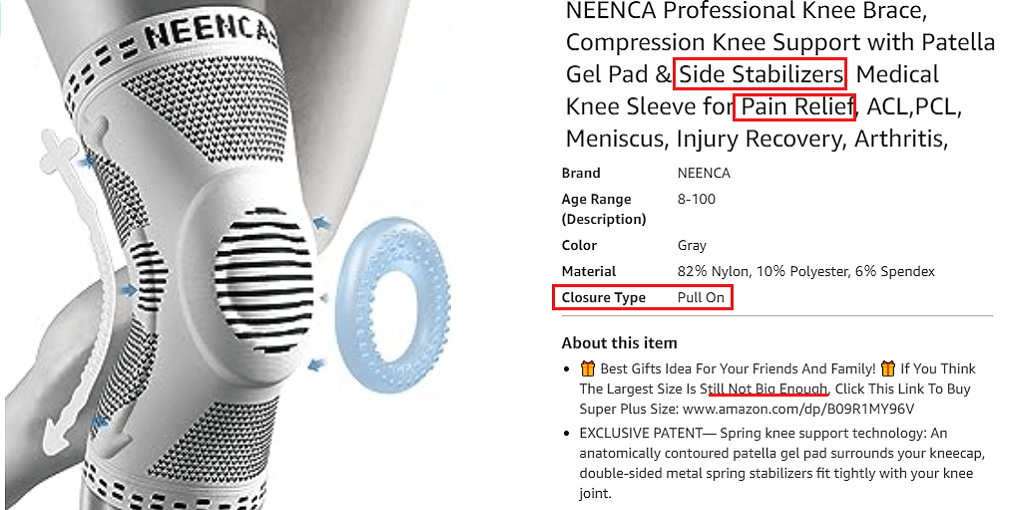
Whether you’re recovering from an injury, suffering from chronic knee pain, or looking for preventive support during physical activities, the NEENCA Knee Brace is engineered to meet your needs.
Key Benefits
- Multi-layered support for comprehensive knee joint protection
- Medical-grade compression sleeve to reduce swelling and improve blood circulation
- Adjustable straps with Velcro closures for customized support and comfort
- Patella stabilizer pad for targeted kneecap support
- Anti-slip silicone grips to prevent slipping during physical activities
- Suitable for sports, exercise, daily wear, and post-injury rehabilitation
- Available in a unisex design and various sizes for a comfortable fit
- Designed to provide stability, comfort, and relief for knee-related issues
- Breathable and moisture-wicking fabric for comfort during extended wear
- Durable construction for lasting support and protection
- Helps to reduce the risk of patellar displacement and knee injuries
- Suitable for a wide range of knee conditions, including arthritis and tendonitis
- Lightweight and low-profile design for discreet wear under clothing
- Can be used on either the left or right knee for convenience
- Provides support without limiting your range of motion
- Ideal for use during various sports activities, including running, basketball, and more
- Trusted by athletes and individuals for its effectiveness and comfort
User Experience
Having worked with the NEENCA Professional Knee Brace, I can confidently say that it is a remarkable product designed to provide excellent support and relief for individuals suffering from knee pain or injuries.
The knee brace is crafted with meticulous attention to detail and incorporates advanced features, making it an outstanding choice for those seeking a reliable and effective solution.
NEENCA Professional Knee Brace is its exceptional comfort. The brace is constructed using high-quality, breathable materials that allow for optimal airflow and ventilation, thus preventing discomfort and perspiration even during prolonged use.
The soft inner lining feels gentle against the skin, providing a cushioning effect without compromising on stability.
It is its adjustable and secure fit. The brace features a dual-elastic strapping system that ensures a customizable and snug fit for users of various sizes.
The straps are equipped with strong fastener closures that securely hold the brace in place, preventing it from slipping or shifting during physical activities or daily routines.
This level of stability is particularly beneficial for individuals engaged in sports or demanding activities that put a strain on the knee joint.
Overall, based on my experience, I recommend the NEENCA Professional Knee Brace to anyone in need of reliable knee support.
Its exceptional comfort, adjustable fit, targeted support, and durability make it a top choice for individuals seeking effective pain relief and stability for their knees.
Reasons To Like
- Effective Support
- Adjustable Fit
- Comfortable Design
Reasons to Avoid
- Limited Patella Support
- Potential Slippage
4. Bracoo Adjustable Compression Knee Patellar Pad
The Bracoo Adjustable Compression Knee Patellar Pad is a versatile and effective orthopedic support device designed to provide stability, pain relief, and enhanced mobility for individuals dealing with various knee-related issues.
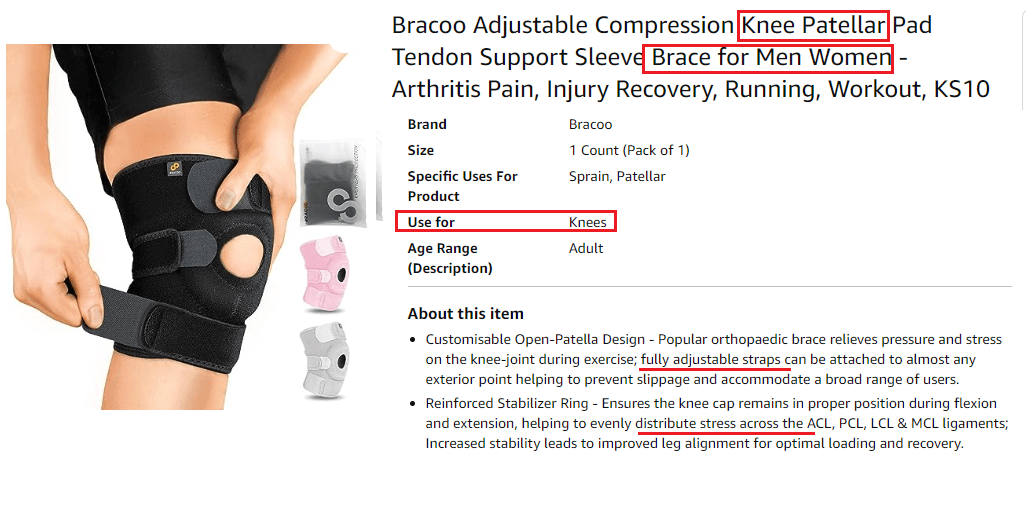
This knee brace is known for its innovative design and focus on delivering comfort and support to users of all activity levels.
Key Benefits
- Features a customizable patellar pad for stabilizing the kneecap and promoting proper alignment
- Adjustable straps with Velcro closures allow users to tailor the compression level to their comfort and specific requirements
- Made from breathable and moisture-wicking materials to ensure comfort during extended wear
- Includes anti-slip silicone grips to prevent the brace from slipping or bunching during physical activities
- Suitable for a wide range of activities, including sports, workouts, daily wear, and post-injury recovery
- Constructed with durable materials to withstand the rigors of active lifestyles
- Available in a unisex design and various sizes to accommodate users of different body types
- The adjustable patellar pad offers targeted support to address issues related to the kneecap, such as patellar tracking problems and instability
- Its breathable and moisture-wicking material helps keep your knee dry and comfortable, even during extended periods of wear
- Suitable for post-injury rehabilitation, it aids in the healing process by providing support and reducing strain on the knee
- The brace is typically easy to clean, ensuring hygiene and maintaining its effectiveness over time
User Experience
I recently had the opportunity to try out the Bracoo Adjustable Compression Knee Patellar Pad, and I must say, it exceeded my expectations.
As someone who suffers from occasional knee pain, I was looking for a reliable knee brace that would provide the necessary support and comfort to alleviate my discomfort. The Bracoo knee brace did just that and more.
Right from the moment I put on the Bracoo knee brace, I could feel the difference. The adjustable compression feature allowed me to customize the level of support I needed for my knee.
The straps were easy to adjust, ensuring a snug and secure fit without any discomfort or irritation.
This was particularly important to me as I wanted a brace that would stay in place during different activities, whether I was going for a jog or simply going about my daily routine.
It provided targeted compression around the kneecap area, offering additional stability and alleviating pressure on the joint.
This was especially beneficial during intense physical activities when my knee required extra support.
The pad was designed to stay in position, keeping my patella properly aligned and preventing any unnecessary movement that could potentially cause further pain or injury.
The Bracoo knee brace is made from high-quality materials that are not only durable but also breathable.
In conclusion, my experience with the Bracoo Adjustable Compression Knee Patellar Pad has been nothing short of positive.
It offered the perfect combination of support, comfort, and durability that I was looking for in a knee brace.
Whether it was for everyday use or engaging in physical activities, the Bracoo knee brace provided the necessary protection and support to help alleviate my knee pain and enhance my mobility. I would recommend it to anyone in need of a reliable and versatile knee brace.
Reasons To Like
- Effective Knee Support
- Customizable Compression
- Breathable Material
Reasons to Avoid
- Sizing Challenges
- Bulkiness Under Clothing
- Slippage Potential
5. Modvel Knee Braces for Knee Pain Women & Men
Modvel Knee Braces for Knee Pain are a trusted and versatile orthopedic solution designed to provide effective support and relief for both women and men dealing with knee discomfort and injuries.
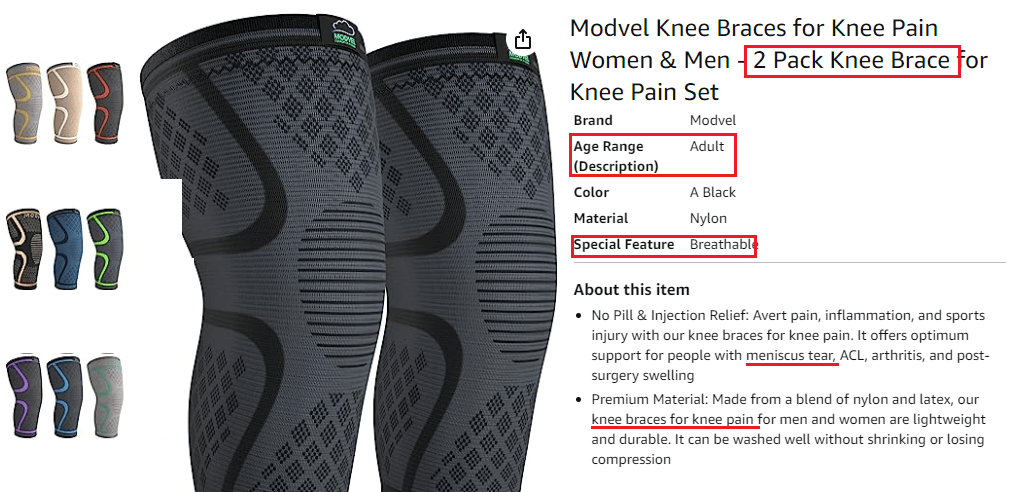
These knee braces are renowned for their quality, durability, and comfort, making them a popular choice among individuals seeking to enhance their knee stability and mobility.
Key Benefits
- Customizable compression levels with adjustable straps and Velcro closures
- Incorporated patellar stabilizers for proper kneecap alignment and reduced dislocation risk
- Made from breathable and moisture-wicking materials for comfort during extended wear
- Inner lining with anti-slip silicone grips to prevent slippage or bunching during activities
- Available in a unisex design and various sizes to accommodate users of different body types
- The breathable and moisture-wicking material helps prevent sweat buildup, keeping your knee dry and comfortable during extended wear
- These knee braces may help enhance athletic performance by reducing the risk of knee injuries and discomfort during physical activities
- Suitable for post-injury rehabilitation, they provide support to the healing process and reduce strain on the knee
- The braces are typically easy to clean, ensuring hygiene and maintaining their effectiveness over time
- Available in various sizes, these knee braces can accommodate a wide range of body types and ensure a comfortable fit for all users
- The unisex design makes these braces suitable for both men and women, making them a versatile solution for various knee-related issues
User Experience
I recently got the opportunity to test out Modvel Knee Braces for Knee Pain, which are available for both men and women.
As someone who routinely suffers from knee pain, I was eager to find a solution that would bring some relief. These knee braces far exceeded my expectations.
Modvel Knee Braces are incredibly comfortable to wear. The soft and breathable material feels gentle against the skin, preventing any irritation, even after extended periods of use.
The adjustable straps allow for a customizable fit, ensuring that the braces stay securely in place without restricting movement.
The Modvel Knee Braces are also incredibly versatile. They can be used by both men and women, making them a great option for couples or households with multiple individuals suffering from knee pain.
Additionally, they are suitable for various activities, such as running, hiking, or even just walking around the house.
They offer a comfortable fit, exceptional support, and are built to last. They have certainly made a significant difference in my daily life, allowing me to move with greater ease and comfort.
Reasons To Like
- Customizable Compression
- Breathable and Comfortable
- Versatile Use
- Affordable
Reasons to Avoid
- Sizing Challenges
- Bulkiness Under Clothing
- Limited Patellar Support
6. Doufurt Knee Brace with Side Stabilizers for Meniscus Tear Knee Pain
The Doufurt Knee Brace with Side Stabilizers is an advanced orthopedic support device designed to provide effective relief and stability for individuals dealing with knee pain and injuries, particularly meniscus tears.
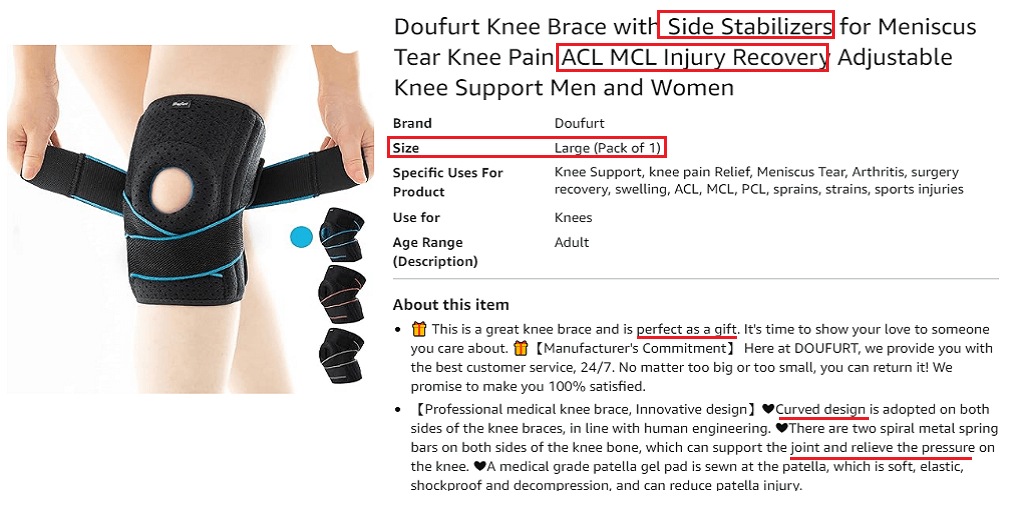
This knee brace offers a combination of targeted support, durability, and comfort, making it a popular choice for those seeking to alleviate knee discomfort and improve their mobility.
Key Benefits
- Integrated side stabilizers provide additional support and prevent lateral knee movement
- Customizable compression and support levels with adjustable straps
- Relieves pressure on the kneecap while ensuring proper alignment
- Constructed from breathable, moisture-wicking materials for comfort during extended wear
- Inner lining includes non-slip silicone grips to prevent slippage during physical activities
- Suitable for sports, workouts, daily wear, and post-injury rehabilitation
- Available in a unisex design and various sizes for a comfortable fit for users of different body types
- Suitable for post-injury rehabilitation, it aids in the healing process by reducing strain on the knee and providing support
- The open-patella design reduces pressure on the kneecap, which can help alleviate discomfort and pain associated with meniscus tears
- Whether you're participating in sports, working out, or going about your daily activities, this knee brace is versatile and adaptable to your needs
- While providing effective support, the brace has a relatively low-profile design that allows it to be worn discreetly under clothing
- The knee brace is typically easy to clean, ensuring hygiene and maintaining its effectiveness over time
User Experience
I just had the chance to test out the Doufurt Knee Brace with Side Stabilizers, which was built exclusively for meniscus tear knee pain.
As someone who had a meniscus tear, I was eager to find a knee brace that would give me the support and stability I required during my recuperation. This knee brace really exceeded my expectations.
Doufurt Knee Brace is exceptionally well-designed. The side stabilizers, made from sturdy and durable material, offer targeted support to the affected area.
They effectively align and protect the knee joint, reducing pain and preventing further injury. The brace fits snugly yet comfortably, thanks to the adjustable straps that allow for a customizable fit.
The Doufurt Knee Brace’s versatility is also worth mentioning. It is suitable for both men and women, making it a great option for anyone dealing with meniscus tear knee pain.
Additionally, the brace is slim and compact, allowing for easy and discreet wear under clothing. I appreciated the fact that I could continue with my daily activities without feeling restricted or self-conscious.
It has shown to be a dependable and successful treatment for my meniscus tear knee pain. If you have a similar injury or condition, I recommend trying this knee brace.
Its supporting design, comfort, and longevity make it an invaluable aid on the road to recovery and increased mobility.
Reasons To Like
- Customizable Compression
- Versatile Use
- Open-Patella Design
- Durable and Affordable
Reasons to Avoid
- Sizing Challenges
- Bulkiness Under Clothing
7. DR. BRACE ELITE Knee Brace with Side Stabilizers
The DR. BRACE ELITE Knee Brace with Side Stabilizers is a highly regarded orthopedic support device designed to provide effective stability, support, and pain relief for individuals dealing with knee-related issues.
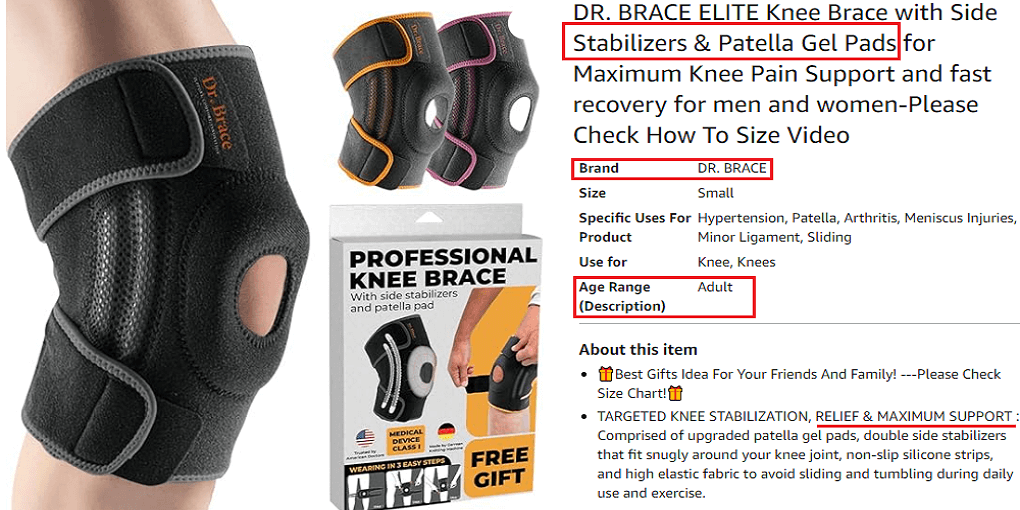
This knee brace offers an advanced combination of features and technologies to address a wide range of conditions, making it a popular choice for those seeking enhanced knee support and comfort.
Key Benefits
- Integrated side stabilizers provide extra support and prevent lateral knee movement
- Customizable compression and support with adjustable straps featuring strong Velcro closures
- Relieves pressure on the kneecap, promoting proper alignment and potentially reducing discomfort
- Constructed with breathable and moisture-wicking materials for comfort during extended wear
- Inner lining includes non-slip silicone grips to prevent slippage during physical activities
- Designed for long-term use, constructed with durable materials
- Putting on and adjusting the brace is straightforward, making it convenient for daily use or during physical activities
- Suitable for post-injury rehabilitation, it aids in the healing process by reducing strain on the knee and providing support
- The open-patella design relieves pressure on the kneecap, potentially reducing discomfort and pain associated with various knee conditions
- Whether you're engaging in sports, working out, or simply going about your daily routine, this knee brace is versatile and adaptable to your needs
- While providing effective support, the brace has a relatively discreet design that allows it to be worn inconspicuously under clothing
- The knee brace is typically easy to clean, ensuring hygiene and maintaining its effectiveness over time
User Experience
I recently had the opportunity to try out theDR. BRACE ELITE Knee Brace with Side Stabilizers, and I must say that it has been a game changer in my knee pain management.
As someone who has experienced with chronic knee problems, I was eager to find a knee brace that could provide the necessary support and stability. My hopes were exceeded with the DR. BRACE ELITE Knee Brace.
The first thing I noticed about this knee brace was its exceptional build quality. The brace itself is made of high-quality materials, ensuring durability and long-lasting performance.
The side stabilizers, specifically designed to provide enhanced support, are sturdy and effective.
They helped keep my knee properly aligned, reducing pain and preventing further injury during physical activities.
The adjustability of the DR. BRACE ELITE Knee Brace is another standout feature. With its customizable straps and closures, I was able to achieve a perfect fit that offered both comfort and support.
The brace hugged my knee securely, providing a sense of stability without feeling overly restrictive. This allowed me to move freely while still benefiting from the added support.
Overall, my experience with the DR. BRACE ELITE Knee Brace with Side Stabilizers has been exceptional. It is a dependable and effective treatment for controlling knee discomfort and enabling a more active and pain-free lifestyle.
If you have knee problems or want to avoid future injuries, I highly recommend trying this knee brace.
Its high-quality design, adaptability, and comfort make it a standout option among knee braces.
Reasons To Like
- Open-Patella Design
- Durability and Affordability
Reasons to Avoid
- Bulkiness Under Clothing
- Limited Patellar Support
8. Physix Gear Sport Knee Support Brace
The Physix Gear Sport Knee Support Brace is a well-regarded orthopedic solution designed to provide effective support, stability, and pain relief for individuals dealing with various knee-related issues.
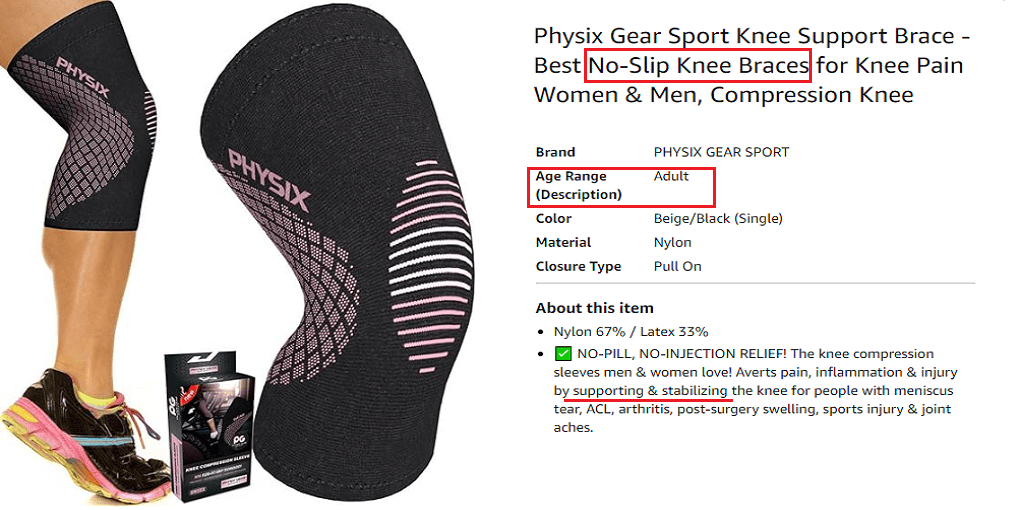
Known for its durability, versatility, and comfort, this knee support brace is a popular choice for those seeking reliable knee support during physical activities and daily life.
Key Benefits
- Provides enhanced stability and lateral support to the knee joint
- Customizable compression and support with adjustable straps and strong Velcro closures
- Relieves pressure on the kneecap while promoting proper alignment
- Constructed with breathable and moisture-wicking materials for comfort during extended wear
- Inner lining includes non-slip silicone grips to prevent slippage during physical activities
- Suitable for sports, workouts, daily wear, and post-injury rehabilitation
- Putting on and adjusting the brace is straightforward, making it convenient for daily use or during physical activities
- Suitable for post-injury recovery and rehabilitation, the brace aids in the healing process by reducing strain on the knee and providing support
- Despite its stability-focused design, many users find the brace comfortable for extended wear, making it suitable for various activities
- This brace is versatile and can be used for different knee-related issues, making it a valuable addition to your orthopedic support collection
- The knee support brace is typically easy to clean, ensuring hygiene and maintaining its effectiveness over time
User Experience
I had the chance to test out the Physix Gear Sport Knee Support Brace, and I have to admit that it made a lasting impact.
I frequently rely on the support and stability offered by a good knee brace because I enjoy a variety of physical activities, such as jogging and hiking.
The Physix Gear Sport Knee Support Brace not only met, but in many ways surpassed, my expectations.
One of the first things I noticed about this knee brace was its exceptional build quality. It is made from a durable and breathable neoprene fabric that not only feels comfortable against my skin but also provides excellent compression and support to my knee joint.
The brace is also reinforced with sturdy straps and a non-slip silicone grip, ensuring that it stays securely in place during rigorous activities.
The design of the Physix Gear Sport Knee Support Brace is another standout feature. It features an open-patella design that allows for better ventilation and prevents uncomfortable heat buildup.
The brace also has a unique four-way stretch capability, which allows for a snug fit while still allowing a full range of motion.
This was particularly noticeable during my runs, as I experienced enhanced stability without feeling constricted.
Furthermore, I appreciated the attention to detail that went into the design of this knee brace.
It has additional support panels around the patella, as well as reinforced stitching in critical areas, providing extra reinforcement where it is needed most.
This feature gave me peace of mind, knowing that my knee was well-protected and supported throughout my activities.
Its excellent build quality, thoughtful design, and versatility make it a top choice for anyone seeking reliable knee support.
Whether you’re an athlete looking to prevent injuries or someone with knee discomfort seeking relief, this knee brace is definitely worth considering.
Reasons To Like
- Pain Relief
- Quick Recovery
- Multi-Purpose Use
- High-Quality Materials
Reasons to Avoid
- Sweat Accumulation
- Complexity
9. Bodyprox Patellar Tendon Support Strap (Large)
The Bodyprox Patellar Tendon Support Strap, available in a large size, is a popular orthopedic solution designed to provide targeted support and pain relief for individuals dealing with patellar tendonitis, runner’s knee, and various other knee-related issues.
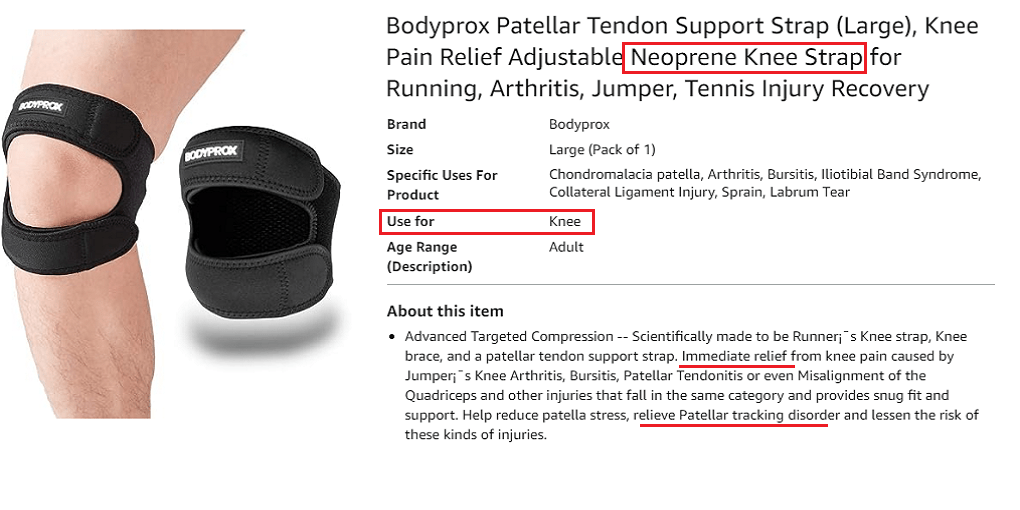
This support strap is known for its simplicity, comfort, and effectiveness, making it a preferred choice for those seeking a practical solution to alleviate knee pain.
Key Benefits
- Designed to stabilize the patella (kneecap) and alleviate discomfort associated with patellar tendonitis and runner's knee
- Features an adjustable strap with a durable Velcro closure, allowing for personalized compression and support
- Designed to fit a wide range of users with different body types, making it suitable for many individuals
- Constructed from soft, breathable, and moisture-wicking materials to ensure comfort during extended wear
- The inner lining includes non-slip silicone grips to prevent slippage, ensuring the strap stays securely in place
- Offers quality knee support at an accessible price point, making it a cost-effective solution for knee pain relief
- Putting on and adjusting the strap is straightforward, making it convenient for daily use or during physical activities
- The slim and lightweight design allows for discreet wear under clothing without feeling bulky or restrictive
- This strap provides focused support for the patellar tendon without unnecessary complexity or features
- It can be beneficial for post-injury rehabilitation, helping users regain knee stability and comfort
- The Bodyprox Patellar Tendon Support Strap offers a budget-friendly option for individuals seeking relief from patellar-related knee pain
- While the strap is relatively simple, it is often durable and capable of withstanding regular use over time
User Experience
I recently had the chance to test out the Bodyprox Patellar Tendon Support Strap in size Large, and I have to admit that it significantly helped to relieve my knee pain and supported it while I was exercising.
I frequently feel pain and tension in my patellar tendon as a result of the intense exercises I perform, such as running and weightlifting.
I found that the Bodyprox Patellar Tendon Support Strap was a useful supplement to my fitness program.
The design of the Bodyprox Patellar Tendon Support Strap is simple yet effective.
It features a tubular-shaped pad that sits directly over the patellar tendon, providing targeted support and relieving pressure on the tendon during activities.
The pad is made from a soft and breathable fabric that keeps my knee cool and comfortable, even during intense workouts.
I also noticed that the strap did not hinder my range of motion, allowing me to perform exercises with ease.
Bodyprox Patellar Tendon Support Strap holds up well. It is made from high-quality materials and withstands frequent use and washing without losing its shape or elasticity.
The Velcro closure system ensures a secure attachment and is easy to adjust as needed.
It provides excellent support, compression, and relief for the patellar tendon, allowing me to engage in physical activities with reduced pain and improved stability.
Whether you’re an athlete looking to prevent injuries or someone seeking relief from patellar tendon issues, I highly recommend to use it.
Reasons To Like
- Ease of Use
- Pain Relief
- Versatile Use
Reasons to Avoid
- Minimalist Design
- Limited Customization
10. BLITZU Knee Braces for Knee Pain Women & Men
The BLITZU Knee Braces for Knee Pain Women & Men are a popular choice for individuals seeking effective knee support and pain relief.
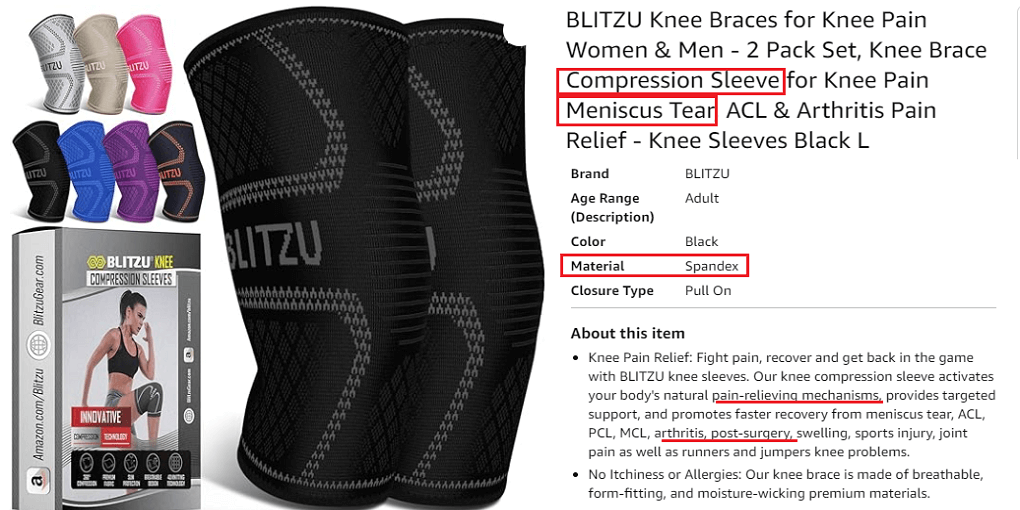
These knee braces are designed to provide stability and comfort for various knee-related issues, making them suitable for both men and women.
With their innovative design and features, they aim to help users regain mobility and alleviate discomfort associated with knee conditions.
Key Benefits
- Reduces pressure on the kneecap (patella) for proper alignment and potential discomfort reduction
- Customizable compression and support with adjustable straps, ensuring a secure and comfortable fit
- Constructed from breathable and moisture-wicking materials to keep the knee dry and comfortable during extended wear
- Inner lining includes non-slip silicone grips to prevent slippage, ensuring the braces stay securely in place
- Offers compression support to reduce swelling, inflammation, and promote circulation for pain relief
- Suitable for a wide range of activities, including sports, workouts, daily wear, and post-injury rehabilitation
- Designed for both women and men, catering to users of various genders and body types
- Provides quality knee support at a competitive price point, making it accessible to a wide range of users
- The braces feature a slim and lightweight design, ensuring they can be discreetly worn under clothing without feeling bulky or restrictive
- Easy to put on and adjust, making them convenient for daily use or during physical activities
- Despite their lightweight design, these knee braces are made from durable materials designed to withstand regular wear and tear
- Suitable for various knee-related issues, including strains, sprains, arthritis, and general knee pain
- These braces provide support without limiting mobility, allowing users to move comfortably during activities
User Experience
I recently got the opportunity to try out the BLITZU Knee Braces for Knee Pain, which are made for both men and women, and I must say that I was really impressed with its performance.
As someone who maintains a busy lifestyle and occasionally gets knee difficulty, I was looking for a knee brace that would provide dependable support and ease pain. The BLITZU Knee Braces exceeded my expectations in a variety of ways.
They are made from a soft and breathable neoprene material that feels gentle against the skin and allows for optimal ventilation, preventing sweat build-up during rigorous activities.
I found that the braces conformed well to the shape of my knees, providing a snug and secure fit without any uncomfortable pressure points.
The versatility of these knee braces also impressed me. They are suitable for a wide range of activities, including sports, gym workouts, and even everyday use.
Whether I was engaging in high-impact exercises or simply going about my daily routine, the BLITZU Knee Braces offered consistent and reliable support.
I found that they effectively reduced discomfort associated with conditions like arthritis, tendonitis, and general knee pain.
Lastly, the durability of the BLITZU Knee Braces is commendable. Despite regular use and washing, they maintained their shape, elasticity, and quality.
The stitching is strong, and the materials used are built to withstand the rigors of regular exercise and activity.
Their comfort, targeted support, versatility, and superior fit make them an excellent choice for anyone seeking reliable knee support.
Whether you’re an athlete looking for added stability or an individual dealing with knee discomfort, these knee braces are definitely worth considering. I highly recommend giving them a try.
Reasons To Like
- Open-Patella Design
- Adjustable Straps
- Breathable and Moisture-Wicking
- Multi-Purpose Use
Reasons to Avoid
- Minimalist Support
- Potential Slippage
- Cost Considerations
11. SHENGYADE Copper Knee Braces for Knee Pain Men and Women
The SHENGYADE Copper Knee Braces for Knee Pain are designed to provide comprehensive knee support and pain relief for both men and women.
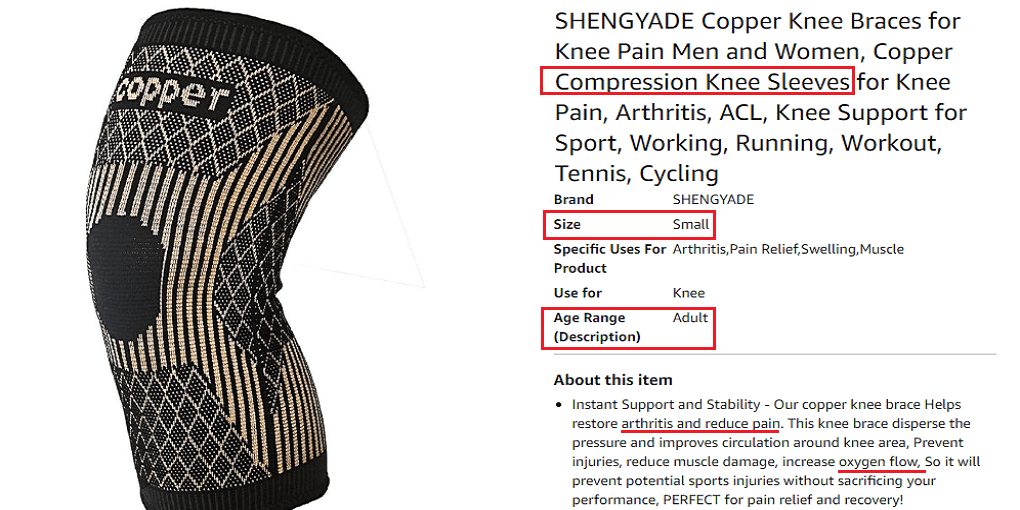
These knee braces incorporate copper-infused fabric, which is believed to have potential benefits for joint health and pain management. With their innovative design and features, they aim to help users regain mobility and alleviate discomfort associated with a variety of knee conditions.
Key Benefits
- Made with copper-infused fabric believed to have natural anti-inflammatory and pain-relieving properties
- Customizable compression with adjustable straps for a secure and personalized fit
- Relieves pressure on the kneecap (patella) and promotes proper alignment
- Constructed from breathable materials that wick away moisture, ensuring dry and comfortable wear
- Inner lining includes non-slip silicone grips to prevent slippage during movement
- Suitable for sports, workouts, daily wear, and post-injury rehabilitation, accommodating different lifestyles and knee conditions
- Designed for both men and women, catering to users of various genders and body types
- Offers quality knee support at a competitive price point, making it accessible to a wide range of users
- Easy to put on and adjust, making them convenient for daily use or during physical activities
- These knee braces are typically designed to withstand regular use and maintain their effectiveness over time
- These braces are designed to provide support without significantly limiting mobility, allowing users to move comfortably during various activities
- Suitable for addressing a variety of knee issues, including arthritis, patellar tendonitis, general knee pain, and post-injury rehabilitation
- Safe for individuals with latex allergies or sensitivities
User Experience
I was in search of a knee brace that could provide the support and relief I needed. The SHENGYADE Copper Knee Braces not only met my expectations but exceeded them in several ways.
I could feel the difference in comfort and support. The fabric is incredibly soft and breathable, allowing for airflow and preventing any excessive sweating or discomfort during physical activities.
The brace conforms perfectly to the shape of my knee, providing a snug and secure fit without any irritating pressure points.
It feels lightweight and doesn’t restrict my range of motion, allowing me to engage in various exercises comfortably.
Another aspect I appreciate about these knee braces is their versatility. Suitable for both men and women, they are designed for a wide range of activities, including sports, gym workouts, and everyday use.
I used them during my runs, weightlifting sessions, and even while performing chores around the house.
The SHENGYADE Knee Braces provided consistent support and pain relief in all these scenarios, allowing me to focus on my activities without being hindered by knee discomfort.
The comfort, support, and the added benefit of the copper infusion make these braces a standout choice for anyone seeking relief from knee pain.
Whether you’re an athlete looking for enhanced stability or an individual dealing with knee discomfort, these knee braces are certainly worth considering.
Reasons To Like
- Copper-Infused Fabric
- Adjustable Compression
- Open-Patella Design
Reasons to Avoid
- Sizing Constraints
- Limited Support for Severe Knee
- Cost Considerations
12. OrthoSleeve Orthopedic Brace for Tendinitis
The OrthoSleeve Orthopedic Brace for Tendinitis is a specialized orthopedic support designed to provide targeted relief and support for individuals suffering from tendinitis.
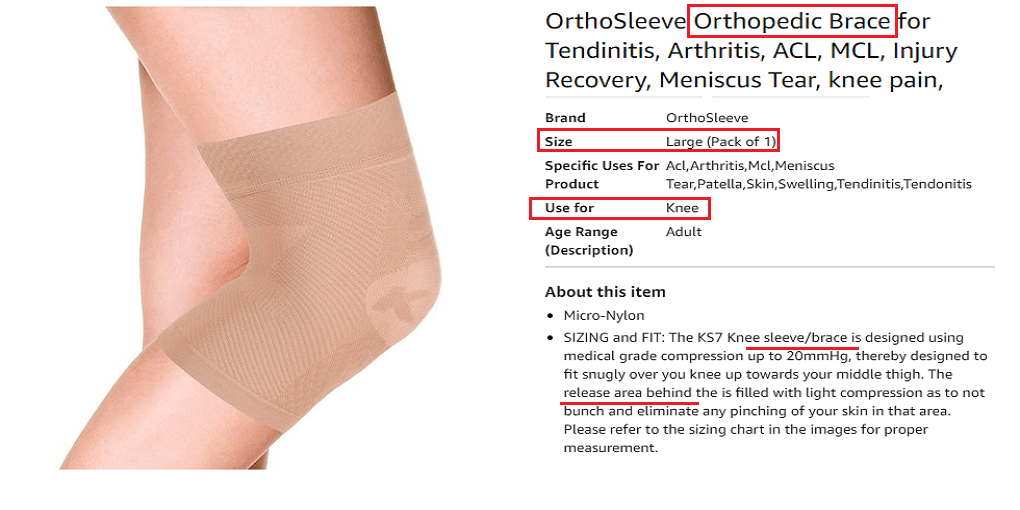
Tendinitis, often characterized by inflammation and irritation of tendons, can lead to significant discomfort and reduced mobility.
This orthopedic brace aims to alleviate these symptoms, allowing users to maintain an active lifestyle while addressing their tendinitis-related issues.
Key Benefits
- Provides targeted compression and support to alleviate discomfort and inflammation associated with tendinitis
- Utilizes medical-grade graduated compression technology to improve blood circulation and aid in the recovery process
- Constructed from breathable, moisture-wicking materials to keep the affected area dry and comfortable
- Designed with an anatomical contour that matches the shape of the affected area, ensuring a secure and comfortable fit
- Suitable for various tendinitis-related conditions, including Achilles tendinitis, patellar tendinitis, and golfer's elbow
- Designed for easy and convenient application, making it user-friendly
- The brace's gradual compression helps reduce inflammation, alleviate pain, and support the healing process of tendinitis
- Typically available in various sizes to accommodate different body types and specific areas affected by tendinitis
- Suitable for addressing tendinitis in various areas of the body, including the Achilles tendon, patellar tendon, and other affected joints
- The brace's design and materials aim to minimize discomfort and irritation, allowing for extended wear without chafing or skin irritation
- Built to withstand regular use and maintain its effectiveness over time
- Designed with the quality and support standards expected from orthopedic products
- Suitable for everyday use, whether at work, during sports, or other daily activities
User Experience
As someone who suffers from chronic tendinitis in my elbow, finding a brace that provides effective support and relief is crucial. The OrthoSleeve Orthopedic Brace has proven to be an exceptional solution.
It incorporates medical-grade compression technology, which not only provides support but also improves circulation and reduces inflammation. The compression feels comfortable and secure without being overly tight or restrictive.
I appreciate that the brace is designed to target the specific area affected by tendinitis, ensuring that the compression is focused on the problem area.
It fits snugly and discreetly around the elbow, making it easy to wear under clothing without causing any discomfort or bulkiness.
This feature allows me to wear the brace throughout the day, providing continuous support and relief during various activities, such as typing on a computer or participating in light exercise.
The compression level adapts to the wearer’s movements and needs, providing the right amount of support and pressure at all times.
I found that this feature significantly reduced pain and discomfort associated with tendinitis, allowing me to perform daily tasks and engage in activities with less strain on my elbow joint.
Another aspect worth mentioning is the ease of use. The brace slips on and off easily, thanks to its open-sleeve design.
It stays securely in place without any slipping or readjustment required, allowing me to focus on my activities without worrying about the brace shifting.
Overall, I’ve had a really excellent experience with the OrthoSleeve Orthopedic Brace for Tendinitis.
Its one-of-a-kind design, medical-grade compression, and Smart Compression technology have all helped to alleviate and support my tendonitis.
This brace is definitely worth considering if you have tendonitis in your elbow, knee, or other joints.
It provides a pleasant, effective, and long-lasting treatment for managing and alleviating tendinitis symptoms.
Reasons To Like
- Targeted Compression
- Discreet and Comfortable
- Potential Medication Reduction
Reasons to Avoid
- Varied Effectiveness
- Sizing Concerns
13. POWERLIX Knee Compression Sleeve - For Men & Women
The POWERLIX Knee Compression Sleeve is a highly regarded and versatile knee support product designed to cater to both men and women.
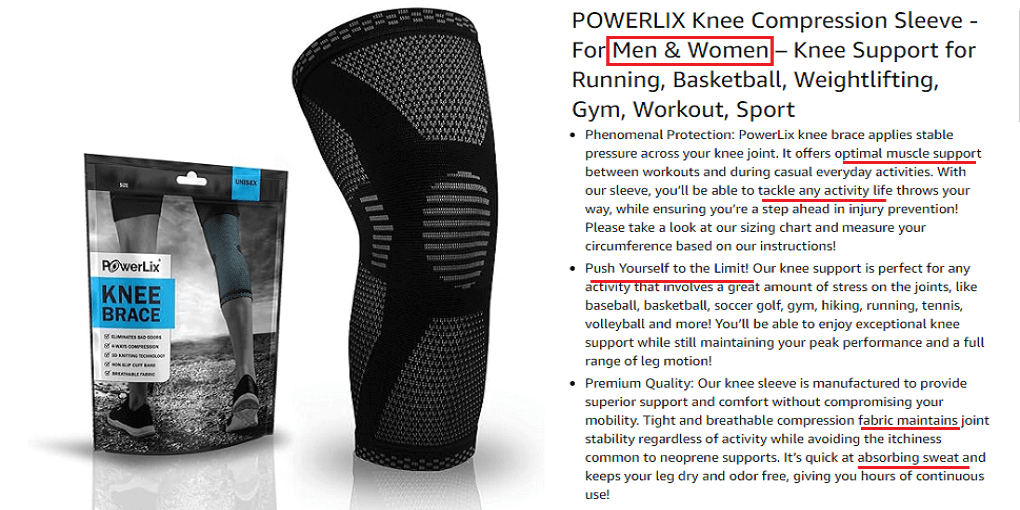
This compression sleeve is engineered to provide comfort, stability, and pain relief for individuals dealing with a wide range of knee-related issues, from sports enthusiasts seeking extra support to those with chronic knee pain.
Key Benefits
- Crafted from high-quality compression fabric for a snug and supportive fit
- Conforms to the natural contours of the knee without limiting range of motion
- Keeps the knee area dry and comfortable during physical activities
- Inner lining includes non-slip silicone strips to prevent slipping during movement
- Provides pain relief and stability for various knee conditions, including arthritis and tendonitis
- Suitable for sports, running, hiking, daily wear, and post-injury rehabilitation
- Accommodates both men and women, catering to various body types
- Available in multiple sizes for a personalized and comfortable fit
- Offers a modern and stylish design that can be worn with confidence
- Provides thermal stabilization, keeping the knee joint warm and promoting blood flow
- Despite its lightweight design, the sleeve is typically made from durable materials designed for regular wear
- Allows for comfortable movement and confident performance during activities
User Experience
I was searching for a knee sleeve that could provide reliable support and alleviate pain. The POWERLIX Knee Compression Sleeve not only met my expectations but exceeded them in numerous ways.
Made from a premium-quality fabric blend, it feels soft against the skin and offers excellent breathability.
I found that it effectively wicks away moisture, ensuring a comfortable and dry experience even during intense workouts.
The sleeve has a four-way stretch design that provides a snug and contoured fit without being constricting, allowing for a full range of motion.
The graduated compression technology used in the sleeve helps improve blood circulation, reducing swelling and inflammation in the knees.
I noticed a significant reduction in discomfort and pain when wearing the sleeve, which allowed me to continue my activities with increased confidence and stability.
Additionally, the durability of the POWERLIX Knee Compression Sleeve is impressive. The reinforced stitching and high-quality materials ensure that it can withstand rigorous use and frequent washing without losing its shape or compressive properties.
The sleeve retains its elasticity and compression even after extended periods of use, making it a reliable companion for long-term knee support.
Whether you’re a dedicated athlete or someone struggling with knee discomfort, I highly recommend trying out this knee sleeve.
It is a reliable and effective solution that can enhance your overall performance and well-being.
Reasons To Like
- Effective Pain Relief
- Secure Fit
- Breathable and Moisture-Wicking
- Stylish Design
Reasons to Avoid
- Varied Effectiveness
- Sizing Challenges
14. Vive Knee Ice Pack Wrap - Cold/Hot Gel Compression Brace
The Vive Knee Ice Pack Wrap is a versatile and effective solution designed to provide both cold and hot therapy to the knee area.
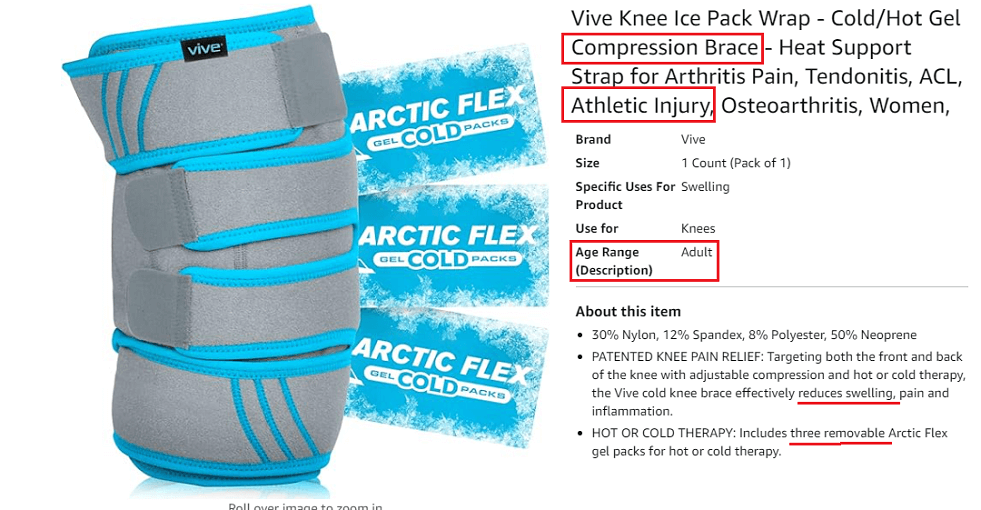
Whether you’re recovering from an injury, dealing with chronic pain, or seeking relief after a strenuous workout, this knee wrap offers customizable temperature therapy to promote healing, reduce inflammation, and alleviate discomfort.
Key Benefits
- Offers both cold and hot therapy options for versatile treatment of knee conditions
- Includes reusable gel packs that can be heated or chilled to provide temperature therapy
- Features adjustable compression straps for a personalized level of support and compression
- Strong fastener straps ensure that the gel packs remain in direct contact with the knee area for consistent therapy
- Designed to fit most knee sizes comfortably, catering to a wide range of users
- Made from breathable neoprene material to prevent excessive sweating and discomfort during use
- Helps alleviate pain associated with knee issues such as arthritis, injuries, and post-surgery discomfort
- Simple and user-friendly design makes it convenient for home therapy
- Suitable for various knee-related problems, including sprains, strains, tendinitis, and general knee pain
- The combination of temperature therapy and adjustable compression aids in faster recovery from knee injuries and discomfort
- The wrap is designed to be user-friendly and convenient for home therapy, allowing you to easily apply temperature therapy to your knee
- Suitable for a wide range of knee-related conditions, including arthritis, sports injuries, post-surgery recovery, and general knee pain
- While providing therapeutic benefits, the wrap allows for comfortable mobility, so you can continue with your daily activities while using it
- The gel packs and adjustable compression straps allow for targeted pain relief by focusing therapy on the knee area
User Experience
I was looking for a system that could deliver compression as well as targeted cold or hot therapy. The Vive Knee Ice Pack Wrap has proven to be a wise investment.
It comes with two adjustable straps that allow for a customized fit and compression level.
The wrap is suitable for both cold and hot therapy, making it convenient for different stages of injury or recovery.
The gel pack can be easily heated in the microwave or chilled in the freezer, providing either soothing warmth or cold relief to the affected knee.
I found that cold therapy was particularly effective in reducing inflammation and swelling. The gel pack stays cold for a significant amount of time, providing long-lasting relief.
I used it after intense workouts or during instances of acute pain, and it helped alleviate discomfort and promote healing. The gel pack conforms well to the knee, distributing the cold evenly and providing targeted relief to the affected area.
The materials used are of high quality, ensuring that the wrap holds up well to regular use and washing.
The stitching is strong, and the gel pack is securely attached to the wrap, providing long-lasting performance.
Whether you’re recovering from an injury, dealing with chronic knee issues, or simply looking for post-workout recovery aid, this wrap is undoubtedly worth considering.
I highly recommend incorporating the Vive Knee Ice Pack Wrap into your wellness routine for targeted relief and enhanced recovery.
Reasons To Like
- Dual Therapy Options
- Reusable Gel Packs
- Adjustable Compression
Reasons to Avoid
- Limited Coverage
- Temperature Control
15. Shock Doctor Compression Knee Brace for Men & Women
The Shock Doctor Compression Knee Brace is a well-regarded product designed to provide support, stability, and compression to the knee joint.
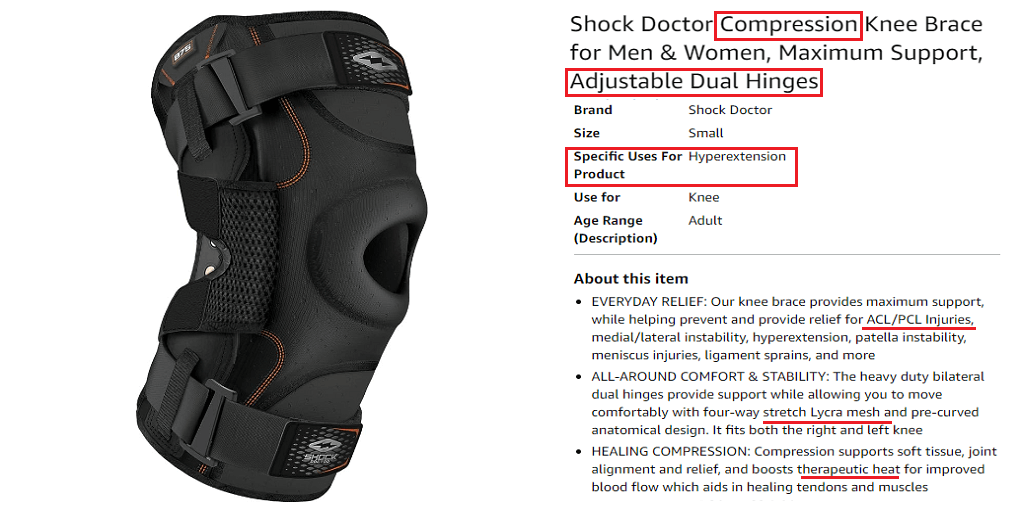
Whether you’re an athlete looking to protect your knees during sports activities or someone dealing with knee pain, this brace offers an effective solution to help you stay active and alleviate discomfort.
Key Benefits
- Provides targeted compression and support to the knee joint
- Designed with an anatomical contour to ensure a secure and comfortable fit
- Constructed from breathable materials that wick away moisture to keep the knee area dry
- Includes non-slip silicone strips to prevent the brace from slipping during movement
- Helps alleviate pain associated with various knee conditions, including arthritis and ligament strains
- Suitable for various activities, including sports, running, hiking, and daily wear
- Accommodates both men and women, catering to different body types
- Available in multiple sizes to ensure a personalized and comfortable fit
- The brace is easy to put on and take off, making it convenient for daily use or during physical activities
- Built to withstand regular use and maintain its effectiveness over time
- The anatomical design and materials allow for comfortable movement and a full range of motion during activities
- Provides thermal stabilization, keeping the knee joint warm and promoting blood flow, which can aid in the recovery process
- Suitable for addressing a variety of knee-related conditions and injuries
- Suitable for everyday use, whether at work, during sports, or other daily activities
User Experience
As someone who leads an active lifestyle and occasionally experiences knee discomfort, finding a knee brace that provides effective support and stability is crucial. The Shock Doctor Compression Knee Brace has proven to be a top choice.
It offers a snug nd supportive fit that helps improve blood circulation and reduces swelling and inflammation.
From the moment I put on the brace, I could feel the compression working to provide instant relief and support to my knee.
The compression is just right—firm enough to provide stability but still allowing a full range of motion.
The design of the Shock Doctor Compression Knee Brace is also worth mentioning. It features an open-patella design, which provides extra support and alignment for the kneecap.
This feature not only helps alleviate pain in the knee joint but also promotes proper tracking of the patella during movement.
I found that the brace effectively reduces pressure on my kneecap, which is particularly beneficial during activities that involve jumping or sudden directional changes.
I also appreciate the versatility of this knee brace. Whether you’re an athlete participating in sports, someone recovering from an injury, or simply seeking extra support during daily activities, the Shock Doctor Compression Knee Brace caters to a wide range of needs.
It provides stability and pain relief for various conditions such as tendonitis, arthritis, and general knee discomfort.
In conclusion, my experience with the Shock Doctor Compression Knee Brace has been exceptional. Its strong compression, supportive design, comfort, and durability make it an outstanding choice for anyone seeking reliable knee support and stability.
Whether you’re recovering from an injury, experiencing chronic knee pain, or looking to prevent future discomfort, this knee brace is an excellent investment.
I highly recommend the Shock Doctor Compression Knee Brace for its superior performance and ability to enhance your knee health and well-being.
Reasons To Like
- Anti-Slip Design
- Improved Blood Circulation
- Enhanced Confidence
- Durable Construction
Reasons to Avoid
- Budget Considerations
- Discomfort During Extended Wear
- Limited Mobility During Application
What are the Benefits of Wearing a Knee Brace
Wearing a knee brace can be helpful. It depends on your condition or situation. Here are some of the potential benefits of wearing a knee brace:
Stability and Support
Manufacturers make knee braces to stabilize the knee joint. Knee braces can assist people with weak or hurt knees.
They keep the knee in the right position and prevent too much movement that might cause more harm.
Pain Relief
Many knee braces provide compression and support. It can reduce knee pain caused by arthritis, tendonitis, or minor sprains.
Injury Prevention
Athletes often use knee braces to reduce the risk of knee injuries. Sudden changes in direction, jumping, or heavy impact are especially common in sports. The brace can help protect the knee from strains, sprains, or ligament injuries.
Post-Injury Rehabilitation
A knee brace can aid in rehabilitation after a knee injury or surgery. It provides controlled movement and support. This helps the injured area heal and regain strength and mobility.
Improved Functionality
Individuals with chronic knee problems or instability can wear a knee brace. This helps them do everyday tasks and stay active. It also allows them to play sports without worrying about their knees.
Reduced Swelling
Some knee braces provide compression. This can help reduce swelling and inflammation in the knee joint. This can be particularly beneficial after an acute injury.
Corrective Alignment
Specific knee braces, like patellar stabilizing ones, aim to align the kneecap. They have a specific design that focuses on aligning the patella.
Enhanced Confidence
Wearing a knee brace can increase an individual’s confidence. It does so by providing stability and support to their knee.
This increased confidence can motivate them to be more active. It may also make them less cautious in their movements.
What are the purposes and functions of knee braces?
Knee braces serve various purposes and functions. It caters to different needs and medical conditions.
The specific purpose and function of a knee brace can depend on the design, type, and intended use.
Here are the primary purposes and functions of knee braces:
- Injury Prevention:Knee braces are used to prevent knee injuries. They are valuable in sports with high-impact or quick direction changes. These braces offer extra knee support, lowering injury risks like sprains and strains.
- Injury Rehabilitation: A healthcare professional may prescribe a knee brace after a knee injury or surgery. This brace helps support and protect the injured area while it heals. It helps control movement and prevents further damage.
- Pain Management: Knee braces can help lessen pain caused by knee conditions such as arthritis, tendonitis, or mild injuries. They provide support and relief. Some braces offer compression, warmth, and stability to reduce discomfort.
- Stability Enhancement: People with knee instability use knee braces. These braces give them stability, especially if they have ACL or MCL tears. Hinged knee braces, in particular, restrict unwanted side-to-side or rotational movements.
- Patellar Support:Patellar stabilizing braces support and align the kneecap (patella). They can be beneficial for conditions like patellofemoral pain syndrome or patellar tendonitis.
- Post-Surgery Support: After knee surgery, like knee replacement or ligament reconstruction, doctors might use a knee brace in the early recovery stages. The knee brace helps protect the surgical area and allows for controlled movement. It’s used to ensure safety and support as you heal.
- Performance Enhancement: Some athletes wear knee braces to enhance their performance. These braces provide more support and stability, helping athletes take part in their sport with less chance of getting hurt.
- Reducing Swelling: Some knee braces offer compression. Compression can lessen swelling and inflammation. It’s especially helpful after an acute knee injury.
- Alignment Correction: Some knee braces are designed to correct abnormal knee alignments, such as bow-leggedness or knock-knees. They work to gradually shift the knee joint into a more proper position.
What are the Different Types of Knee Braces
There are several different types of knee braces, each designed to serve specific functions and address various knee-related issues.
The choice of knee brace depends on the individual’s condition, the level of support needed, and the intended use. Here are the main types of knee braces:
- Knee Sleeves: Knee sleeves are lightweight, flexible, and slip-on braces made of neoprene or similar materials. They provide compression and mild support to the knee joint. Knee sleeves are commonly used for general knee support, pain relief, and to help reduce swelling. They are often worn during activities like weightlifting, and running, or as a preventive measure in sports.
- Hinged Knee Braces: Hinged knee braces are more rigid and feature hinges on both sides of the knee joint. These braces are designed to provide stability and limit the range of motion, making them suitable for individuals with ligament injuries (e.g., ACL or MCL tears) or post-surgery rehabilitation. Hinged knee braces can be customized to control the degree of movement allowed.
- Patellar Stabilizing Braces: Patellar braces are designed to support and properly align the kneecap (patella). They are commonly used to treat conditions like patellofemoral pain syndrome or patellar tendonitis. These braces often have a circular opening around the patella to provide targeted support.
- Functional Knee Braces: Functional knee braces are designed for athletes and individuals with moderate to severe ligament injuries. They provide a high level of support and stability to the knee. Functional knee braces typically have rigid metal or composite frames and are custom-fitted to the individual’s leg. They are often prescribed by healthcare professionals.
- Post-Operative Knee Braces: These knee braces are specifically designed for use after knee surgery, such as ACL reconstruction or knee replacement. They provide a controlled range of motion and support to protect the surgical site during the early stages of recovery.
- Prophylactic Knee Braces: Prophylactic knee braces are worn to prevent knee injuries, particularly in high-impact sports like football or skiing. They provide general support and protection to the knee joint, reducing the risk of injuries like ACL sprains.
- Arthritis Knee Braces: These braces are designed to alleviate pain and discomfort associated with knee arthritis. They often provide compression, warmth, and support to reduce inflammation and improve mobility.
- Unloader Knee Braces: Unloader knee braces are used to shift weight away from the affected side of the knee, typically in cases of knee osteoarthritis or meniscus injuries. They help reduce pain and improve function by relieving pressure on the affected area.
- Custom-Fitted Knee Braces: Custom knee braces are precisely fitted to an individual’s leg and are often prescribed for specific medical conditions or post-surgery recovery. They provide a high level of support and comfort due to their tailored fit.
- Neoprene Knee Braces: These knee braces are made of neoprene material and provide compression and warmth. They are often used for mild knee support, pain relief, and to improve circulation.
How to Choose the Right Knee Brace for You?
Choosing the right knee brace requires considering several factors. Here are some steps to help guide you:
Consult with a Healthcare Professional
Consult a healthcare professional like a sports doctor, orthopedic specialist, or physical therapist. They can assess your specific needs and provide specific recommendations.
Understand the Type of Knee Brace
Different knee braces serve different purposes. Common types include:
- Prophylactic braces: For sports to stop knee injuries. They give knee support.
- Functional braces: After injury or surgery, they support healing knees.
- Unloader/offloader braces: Used with osteoarthritis to ease knee pain.
- Rehabilitative braces: Help with recovery after injury or surgery, allowing controlled movement.
Consider the Specific Condition
Depending on your knee condition, certain features may be more important. If your ligaments are weak, you might need a brace with hinges for more support. If you have arthritis, a brace with cushioning and compression may be beneficial.
Check Size and Fit
It’s crucial to choose a knee brace that fits properly. Measure your knee circumference and refer to the manufacturer’s sizing guide. Most braces are adjustable.
Make sure the brace offers enough compression and support. Also, check that it doesn’t cause discomfort or restrict circulation.
Assess Comfort and Mobility
Try on different braces to determine the level of comfort and mobility they offer. Check if the material is breathable, moisture-wicking, and hypoallergenic. Ensure that the brace does not impede your ability to move comfortably.
Consider Activity Level and Lifestyle
Choose a knee brace that matches your activities. Some are good for low-impact sports, while others provide better protection for high-impact activities.
Understanding Knee Injuries and Conditions
The knee is a complex joint that is made up of bones, ligaments, tendons, and cartilage. It handles bearing weight and allowing the leg to bend and straighten. Knee injuries and conditions can be caused by a variety of factors, including:
- Trauma: This can include falls, accidents, and sports injuries.
- Overuse: This can happen from repetitive activities, such as running or jumping.
- Age: The risk of knee injuries and conditions increases with age.
- Other medical conditions: Medical conditions like arthritis and gout can raise the chances of knee issues.
It’s important to understand knee injuries and conditions. Athletes can use this knowledge to prevent injuries. It helps those caring for people with knee issues.
Here’s an overview of some common knee injuries and conditions:
Anterior Cruciate Ligament (ACL) Injury
- Description: The ACL is a major ligament in the knee that can be torn or sprained, often due to sports injuries, sudden stops or changes in direction, or traumatic accidents.
- Symptoms: Pain, swelling, instability, a popping sound at the time of injury, difficulty walking or bearing weight.
- Treatment: Rest, physical therapy, and sometimes surgical reconstruction for severe tears.
Medial Collateral Ligament (MCL) Injury
- Description: The MCL is located on the inner side of the knee and can be stretched or torn, usually due to direct impact or force from a blow to the outer side of the knee.
- Symptoms: Pain, swelling, instability, difficulty bending the knee, and a feeling of looseness.
- Treatment: Rest, bracing, physical therapy, and in severe cases, surgery.
Meniscus Tear
- Description: The meniscus is a cartilage that cushions the knee joint. Tears can occur due to twisting motions or degenerative changes.
- Symptoms: Pain, swelling, stiffness, clicking or locking of the knee, limited range of motion.
- Treatment: Conservative methods like rest, ice, physical therapy, and sometimes surgical repair or removal of the damaged portion.
Patellofemoral Pain Syndrome (Runner’s Knee)
- Description: This condition involves pain around or under the kneecap, often aggravated by activities like running, climbing stairs, or sitting for extended periods.
- Symptoms: Pain in the front of the knee, especially during or after activities.
- Treatment: Rest, physical therapy, proper footwear, and exercises to strengthen the quadriceps and hip muscles.
Osteoarthritis of the Knee
- Description: Knee osteoarthritis is a degenerative joint condition characterized by the breakdown of cartilage in the knee joint.
- Symptoms: Pain, stiffness, reduced range of motion, swelling, and joint deformity.
- Treatment: Medications, physical therapy, lifestyle modifications, weight management, knee braces, and in severe cases, joint replacement surgery.
Iliotibial Band Syndrome (ITBS)
- Description: ITBS involves pain on the outer side of the knee due to friction of the iliotibial band against the knee joint during repetitive activities.
- Symptoms: Pain on the outer knee, especially during activities like running or cycling.
- Treatment: Rest, ice, stretching, foam rolling, and addressing biomechanical issues contributing to the condition.
Bursitis
- Description: Knee bursitis involves inflammation of the bursae, small sacs of fluid that cushion the knee joint.
- Symptoms: Swelling, warmth, pain, and tenderness around the knee joint.
- Treatment: Rest, ice, anti-inflammatory medications, and in some cases, aspiration of excess fluid or physical therapy.
Read Reviews and Seek Recommendations
- Research different brands and models read customer reviews, and seek recommendations from trusted sources such as healthcare professionals or fellow athletes who may have similar conditions or requirements.
Criteria for Selecting the Best Knee Brace
Selecting the best knee brace requires careful consideration of several key criteria to ensure it effectively addresses your specific needs. Here are the essential factors to consider when choosing a knee brace:
Type of Knee Brace
- Determine the specific purpose of the knee brace (e.g., support, stability, pain relief, injury prevention).
- Choose the appropriate type of knee brace based on your condition or activity (e.g., knee sleeve, hinged brace, patellar stabilizing brace, functional brace).
Consultation with a Healthcare Professional
- Seek advice from a medical professional or orthopedic specialist to diagnose your condition and receive personalized recommendations for the type and level of support required.
Fit and Sizing
- Ensure the knee brace is available in sizes that accommodate your leg dimensions.
- Measure your thigh and calf circumference according to the manufacturer’s sizing guide to select the correct size.
Level of Support
- Choose a knee brace with the appropriate level of support for your condition (e.g., mild, moderate, or maximum support).
- Consider whether adjustable features, such as straps and hinges, are necessary to customize the level of support.
Comfort and Material
- Look for a knee brace made of comfortable and breathable materials to prevent skin irritation and discomfort during extended wear.
- Padding and cushioning can enhance comfort.
Range of Motion
- Determine if you need a knee brace that restricts or allows a specific range of motion. Some braces offer adjustable settings for controlled movement.
Ease of Application
- Choose a knee brace that is easy to put on and take off, especially if you plan to use it frequently.
- Consider whether you can apply it independently or if you need assistance.
Different Knee Brace Materials
Knee braces are made from a variety of materials, each offering different properties and benefits. The choice of material often depends on the type and purpose of the knee brace.
Here are some common materials used in knee braces:
Neoprene
Properties: Neoprene is a synthetic rubber known for its flexibility, durability, and excellent compression properties.
Benefits: Neoprene knee braces provide warmth, compression, and support. They are commonly used for pain relief, mild to moderate support, and sports-related activities.
Nylon and Spandex
Properties: These materials are lightweight, stretchy, and breathable.
Benefits: Knee braces made from nylon and spandex are comfortable to wear and provide a snug fit. They are often used for compression sleeves and braces for general knee support and pain relief.
Elastic Materials
Properties: Elastic materials, such as elastic bands or straps, offer flexibility and the ability to adjust tension.
Benefits: Elastic components are often integrated into knee braces to provide adjustable compression and support. They allow for customization of fit and pressure.
Metal or Composite Hinges
Properties: Hinges are typically made from metals like aluminum or composite materials.
Benefits: Knee braces with hinged components offer stability and controlled movement. They are used for addressing ligament injuries and providing support after surgery.
Foam and Padding
Properties: Foam and padding materials are used to enhance comfort and cushioning.
Benefits: These materials are often incorporated into the interior lining of knee braces to reduce friction, irritation, and pressure points. They improve overall comfort during wear.
Velcro or Hook-and-Loop Fasteners
Properties: These are fabric-based fastening systems with interlocking hooks and loops.
Benefits: Velcro or hook-and-loop fasteners are commonly used in adjustable straps, allowing users to secure knee braces snugly. They offer ease of application and adjustment.
Carbon Fiber
Properties: Carbon fiber is a lightweight and rigid material.
Benefits: Knee braces with carbon fiber components provide excellent strength and support while remaining lightweight. They are used in advanced, high-performance knee braces.
Silicone
Properties: Silicone is a flexible, non-allergenic material.
Benefits: Silicone is often used in patellar stabilizing knee braces and knee sleeves. It helps grip and stabilize the kneecap (patella) while remaining comfortable against the skin.
Choosing a Knee Brace Material
The best knee brace material for you will depend on your individual needs and preferences.
- The type of injury or condition you have: Some materials are better suited for certain types of injuries and conditions than others. For example, neoprene is often a good choice for people with arthritis, while nylon is often a good choice for athletes.
- Your activity level: If you are active, you will need a brace that is made from a durable material that can withstand a lot of wear and tear.
- Your comfort level: Some materials are more comfortable to wear than others. If you need to wear a brace for long periods of time, choose a material that is soft and breathable.
How to Properly Wear a Knee Brace
Properly wearing a knee brace is important for its effectiveness and your comfort. Here are some general steps to follow:
Select the Right Knee Brace
There are various types of knee braces available, such as sleeves, straps, and hinged braces. Choose one that suits your needs and provides the appropriate level of support based on your specific condition.
Position Your Knee Correctly
Start by positioning your knee in a slightly bent position, as this helps with proper alignment and brace placement.
Slide the Brace On
If you have a sleeve-style knee brace, put your foot through the opening and pull it up over your calf, shin, and thigh. Make sure the brace covers the entire knee joint.
Adjust the Straps
If your knee brace has straps, fasten them securely but not too tightly. The straps should provide support without cutting off circulation or causing discomfort.
Ensure Proper Fit
The knee brace should fit snugly but not be overly tight. Check for any wrinkling or bunching of the fabric, as this may indicate that the brace is too loose.
Follow Manufacturer Guidelines
Read and follow the specific instructions provided by the manufacturer. Some knee braces may have additional features or specific usage guidelines that should be adhered to.
Test Mobility
Once the brace is properly in place, move your knee through its full range of motion. Make sure you can comfortably walk, bend, and flex your knee without any restriction or discomfort.
Seek Professional Advice
If you have any questions or concerns about how to properly wear your knee brace, it’s always a good idea to consult with a healthcare professional or physical therapist who can give you personalized guidance based on your condition.
How to Measure for the Right Fit
Measuring for the right fit is essential when it comes to clothing, furniture, or any other item where fit matters. Here are some general guidelines for measuring accurately:
Use the Right Tools
Measuring Tape: A flexible measuring tape is the most accurate tool for most measurements.
Ruler or Yardstick: For flat surfaces or objects.
Wear Appropriate Clothing
If you’re measuring yourself for clothing, wear form-fitting garments or undergarments. Baggy clothes can lead to inaccurate measurements.
Take Accurate Measurements
- Chest/Bust: Measure around the fullest part of your chest or bust, under your arms. Ensure the tape is level and not too tight.
- Waist: Measure around your natural waistline, which is typically the narrowest part of your torso.
- Hips: Measure around the fullest part of your hips, usually around 7-9 inches below your waist.
- Inseam: For pants, measure from your crotch to the bottom of your leg, along the inside of your thigh.
- Sleeve Length: Measure from the top of your shoulder to the wrist.
- Neck: Measure around the base of your neck, where your collar usually sits.
- Head Circumference: Measure around your head, just above your eyebrows.
- Height: Stand upright with your back against a wall and measure from the floor to the top of your head.
Follow Instructions Carefully
For certain garments or products, you may need to follow specific measurement instructions provided by the manufacturer or retailer.
Double-Check and Record
- Ensure that the measurements are accurate by double-checking them before making a purchase or starting a project.
- Record your measurements in a notebook or digitally for future reference.
Consider Fit Preferences
Keep in mind your desired fit when measuring for clothing. Do you prefer a loose, relaxed fit, or a more tailored, slim fit?
Measure Twice, Cut Once
This old adage is particularly important for projects involving cutting materials like fabric or wood. Always double-check your measurements before cutting or making irreversible changes.
How to Determine the Right Size of Knee Brace
Determining the right size of a knee brace is important to ensure proper support and fit. Here are the steps to help you determine the right size:
- Measure your knee circumference: Use a flexible tape measure to measure the circumference around the center of your knee joint. Ensure the tape measure is snug but not too tight.
- Consult the manufacturer’s sizing chart: Different knee brace manufacturers may have their own sizing charts. Refer to the specific manufacturer’s website or packaging for their sizing guidelines.
- Match the measurements to the sizing chart: Compare your knee circumference measurement to the sizing chart provided by the manufacturer. Typically, knee brace sizes are determined by the circumference measurements. Select the size range that most closely fits your measurement.
- Consider additional factors: While the sizing chart is a good starting point, it’s essential to consider additional factors such as body type, height, weight, and any specific instructions from the manufacturer. Some knee braces may offer adjustable straps or closures, allowing for a more customized fit.
- Determine Key Measurements: Measure the circumference at three key points:
- Thigh: Measure the circumference around your thigh about 6 inches (15 cm) above your kneecap.
- Knee: Measure around the circumference of your knee, right over the center of the kneecap.
- Calf: Measure the circumference around your calf, about 6 inches (15 cm) below your kneecap.
Knee Braces for Different Sports
Knee braces can be beneficial for athletes in various sports, providing support, stability, and protection to the knee joint.
The type of knee brace you need may depend on the specific sport you’re participating in, your injury history, and your individual needs. Here are some common sports and the types of knee braces that are often used:
Football
Football players often use hinged knee braces for added stability and protection against hyperextension and lateral (side-to-side) movement.
These braces are designed to allow controlled movement while preventing harmful motions.
Basketball
Basketball players may use compression knee sleeves or lightweight knee braces. These provide support and compression while allowing for agility and quick movements on the court.
Soccer
Soccer players may use knee sleeves or neoprene braces to provide mild support and compression.
These help reduce the risk of minor strains and provide warmth to the knee joint.
Baseball and Softball
Baseball and softball players may use knee sleeves for added support during running and sliding.
Catchers, in particular, often use specialized knee savers, which are wedge-shaped knee cushions to reduce strain when crouching for extended periods.
Volleyball
Volleyball players may benefit from knee pads rather than braces, as they offer cushioning and protection against floor impact during dives and slides.
Tennis and Racquet Sports
Tennis players may use neoprene braces or compression sleeves to provide support and reduce the risk of overuse injuries.
Skiing and Snowboarding
Skiers and snowboarders often use knee braces with hinged support to prevent twisting injuries. These braces provide stability and protection against ski-related accidents.
Running and Distance Sports
Runners and athletes in distance sports may use compression knee sleeves or straps for mild support and to help alleviate conditions like patellar tendonitis.
Knee Braces for Different Conditions
The best knee brace for a specific condition can vary depending on the severity of the condition, individual needs, and the recommendations of a healthcare professional.
Here are some common knee conditions and the types of knee braces that are often recommended:
- Osteoarthritis: Unloader Knee Brace: These braces are designed to shift the weight away from the affected part of the knee joint, reducing pain and improving mobility.
- Anterior Cruciate Ligament (ACL) Injury: Functional Hinged Knee Brace: These braces provide stability and limit movement to protect the injured ACL, often used during rehabilitation and post-surgery recovery.
- Medial Collateral Ligament (MCL) Injury: Medial Collateral Ligament (MCL) Brace: These braces provide support and stability to the MCL while allowing controlled movement.
- Patellar Tendonitis (Jumper’s Knee): Patellar Tendon Strap: These straps provide compression and support to the patellar tendon, reducing pain and improving patellar tracking.
- Meniscus Tear: Hinged Knee Brace: A hinged knee brace can provide support and help limit painful movements while the meniscus heals.
- Runner’s Knee (Patellofemoral Pain Syndrome): Patellar Stabilizing Brace: These braces help keep the patella (kneecap) aligned properly and reduce pain associated with the runner’s knee.
Pediatric Knee Braces
Pediatric knee braces are specifically designed to provide support, stability, and protection for children’s knees during various activities or in certain medical conditions. Here are some common types of pediatric knee braces:
- Patellar Stabilizing Brace: These braces are designed to help stabilize the patella (kneecap) and minimize pain caused by conditions like patellar instability or dislocation. They usually have adjustable straps and padding to provide a customized fit for children.
- Post-Operative Brace: After knee surgery, such as ACL reconstruction or meniscus repair, pediatric post-operative knee braces are often prescribed. These braces provide support and immobilization to protect the healing knee joint during the initial recovery period.
- Osgood-Schlatter Brace: Osgood-Schlatter disease is a common condition in growing children that causes pain and inflammation below the kneecap. Specific braces are available to alleviate discomfort by reducing tension on the patellar tendon while allowing normal knee movements.
- Knee Sleeves: Knee sleeves made of stretchy fabric or neoprene are commonly used for pediatric knee support. They provide compression, warmth, and mild stabilization, which can be helpful for various knee conditions, such as mild sprains or strains.
- Patellofemoral Brace: Similar to adult options, pediatric patellofemoral braces are designed to address conditions like patellofemoral pain syndrome or patellar maltracking. They help align the patella properly and provide support while allowing for normal knee motion.
Using Knee Braces for Injury Prevention
Using knee braces for injury prevention is a common practice in sports and physical activities, especially for individuals who have a history of knee injuries or who participate in high-impact or repetitive-motion sports.
While knee braces can be helpful in reducing the risk of certain injuries, it’s important to understand their limitations and use them appropriately.
Here are some key points to consider when using knee braces for injury prevention:
Understand Their Purpose
Knee braces designed for injury prevention are primarily intended to provide support, stability, and compression to the knee joint.
They can help reduce the risk of specific injuries, such as ligament sprains, by limiting excessive movement or by providing additional support to weakened or vulnerable areas.
Know Their Limitations
Knee braces are not a guarantee against injury, and they may not be effective for all types of injuries.
They are most commonly used for preventing or reducing the risk of injuries like anterior cruciate ligament (ACL) sprains, medial collateral ligament (MCL) sprains, and patellar dislocations.
Proper Sizing and Fit
Ensuring that the knee brace fits correctly is crucial for its effectiveness. Ill-fitting braces can be uncomfortable and may not provide the intended support.
Consult with a healthcare professional or follow the manufacturer’s guidelines for sizing.
Follow Usage Instructions
Use the knee brace as directed by your healthcare provider or the manufacturer’s instructions. Wearing it too tightly or for extended periods may lead to discomfort or skin irritation.
Balance with Strength and Conditioning
While knee braces can provide support, they should not be a substitute for proper strength and conditioning exercises.
Strengthening the muscles around the knee joint and maintaining flexibility are key components of injury prevention.
Consider Activity-Specific Braces
Some sports or activities may require specialized knee braces tailored to the movements and demands of that activity.
For example, athletes participating in football, soccer, or skiing might benefit from sport-specific braces.
Regular Monitoring
If you’re using a knee brace for injury prevention, periodically assess your knee’s condition and consult with your healthcare provider as needed.
They can help determine whether the brace is still necessary or if other preventive measures should be taken.
Innovative Knee Brace Technologies
In recent years, several innovative knee brace technologies have emerged to improve the effectiveness, comfort, and usability of knee braces for individuals with various knee issues, including injuries and chronic conditions.
These technologies aim to enhance support, promote rehabilitation, and provide a better overall experience for users. Here are some notable innovative knee brace technologies:
Smart Knee Braces
These knee braces incorporate sensors and technology to monitor the wearer’s knee movement and provide real-time feedback.
They can track parameters like range of motion, gait analysis, and muscle activity. This data can be used for rehabilitation and to adjust the brace’s settings for optimal support.
Custom 3D Printing
3D printing technology allows for the creation of custom-fitted knee braces tailored to an individual’s anatomy. These braces provide a precise fit, which can enhance comfort and support.
Liquid Crystal Elastomer (LCE) Braces
LCE is a material that changes stiffness in response to temperature. Some knee braces use LCE to provide adjustable support.
As the wearer moves, the brace adapts its stiffness to provide the right level of support during various activities.
Magnetic Field Therapy
Some knee braces incorporate magnets or electromagnetic fields to promote healing and reduce pain. These braces are designed to improve blood flow and reduce inflammation.
Spring-Loaded Braces
Spring-loaded knee braces use mechanical components to provide support and enhance mobility.
They are often used for conditions like osteoarthritis to reduce the load on the knee joint during movement.
Hinged Braces with Range Limiters
These braces include hinges that can be adjusted to limit the range of motion of the knee joint.
They are used in rehabilitation after surgery to control movement and protect the healing joint.
Air Compression Technology
Air compression knee braces use air chambers to apply adjustable pressure around the knee joint.
This technology can help reduce swelling and improve circulation in the affected area.
Nano-fiber Braces
Nanotechnology has enabled the development of lightweight, high-strength fibers that can be used in knee braces. These nano-fiber braces offer enhanced durability and support without adding bulk.
Dealing with Knee Pain Holistically
Dealing with knee pain holistically involves addressing the underlying causes, promoting well-being, and incorporating a combination of natural and lifestyle-based approaches to alleviate pain and improve knee health. Here are some holistic strategies for managing knee pain:
- Physical Therapy: A physical therapist can develop a personalized exercise and stretching program to strengthen the muscles around your knee, improve flexibility, and joint stability.
- Weight Management: Maintaining a healthy weight is crucial for reducing knee pain, especially if excess weight is contributing to the problem. Excess body weight places added stress on the knee joints.
- Nutrition: A balanced diet rich in anti-inflammatory foods can help reduce inflammation in the knee joint. Include foods like fatty fish, fruits, vegetables, whole grains, and spices like turmeric and ginger in your diet.
- Hydration: Staying well-hydrated helps keep the cartilage in your knee joint lubricated and functioning properly.
- Mind-Body Practices: Techniques like meditation, yoga, and deep breathing can help reduce stress and promote relaxation. Stress reduction can indirectly help alleviate knee pain, as stress can exacerbate pain perception.
- Acupuncture: Acupuncture, an ancient Chinese practice, involves the insertion of thin needles into specific points on the body. Many people find relief from knee pain through acupuncture sessions.
- Chiropractic Care: Some individuals with knee pain benefit from chiropractic adjustments, which may help realign the body and reduce pain.
- Herbal Remedies: Herbal remedies like arnica and comfrey may provide relief when applied topically as ointments or creams. However, use caution and consult a healthcare provider before trying herbal remedies, as they can have side effects.
- Cold and Heat Therapy: Applying ice packs (cold therapy) and warm compresses (heat therapy) can help alleviate knee pain and reduce inflammation. Alternate between cold and heat treatments as directed by your healthcare provider.
Debunking Common Myths about Knee Braces
Knee braces are commonly used to provide support and stability to the knee joint, but there are also many myths and misconceptions surrounding their use. Let’s debunk some of the most common ones:
Myth 1: Knee Braces Weaken Your Knee Muscles
Reality: Knee braces are designed to provide support to the knee, not to weaken the muscles. While it’s true that excessive reliance on a brace without exercise and rehabilitation can lead to muscle atrophy over time, when used as recommended by a healthcare professional, knee braces can actually assist in the rehabilitation process by reducing pain and enhancing stability during exercise.
Myth 2: Knee Braces Are Only for Athletes
Reality: Knee braces are not exclusive to athletes. They are used by people of all ages and activity levels. In addition to sports-related injuries, knee braces can be beneficial for individuals with arthritis, ligament injuries, and other knee conditions that may affect their daily activities.
Myth 3: Knee Braces Are a Cure for Knee Pain
Reality: Knee braces are not a cure for knee pain. They can help alleviate pain by providing support and stability, but they do not address the underlying cause of the pain. It’s essential to consult with a healthcare professional to diagnose and treat the root cause of your knee pain, which may involve physical therapy, medication, or surgery in some cases.
Myth 4: All Knee Braces Are the Same
Reality: There are various types of knee braces designed for different purposes. Some provide compression and support, while others offer more significant stability for specific injuries or conditions. The type of knee brace you need depends on your injury or condition, so it’s essential to consult with a healthcare provider for proper guidance.
Myth 5: Knee Braces Must Be Worn at All Times
Reality: While some people may need to wear knee braces during daily activities or sports, it’s not always necessary to wear them continuously. Your healthcare provider will recommend the appropriate usage based on your injury or condition. In some cases, they ma recommend wearing the brace only during specific activities or for a limited period during the day.
Myth 6: Knee Braces Are Uncomfortable
Reality: Modern knee braces are designed with comfort in mind. They are often adjustable and made from lightweight materials that provide support without causing excessive discomfort. Proper fitting and adjustments can significantly improve comfort.
Myth 7: Knee Braces Guarantee Injury Prevention
Reality: While knee braces can help reduce the risk of certain knee injuries, they cannot guarantee injury prevention. Injuries can still occur even when wearing a brace, so it’s crucial to practice proper techniques, warm-up exercises, and conditioning to minimize the risk of injury.
Specialized Knee Braces
Specialized knee braces are designed for specific medical conditions or injuries that require targeted support and protection.
These braces are often prescribed by healthcare professionals to address particular issues. Here are some examples of specialized knee braces and the conditions they are designed to treat:
- ACL (Anterior Cruciate Ligament) Brace: ACL injuries are common, especially among athletes. ACL braces are designed to provide stability and support to the knee after an ACL tear or reconstruction surgery. They help limit excessive movement and protect the healing ligament.
- PCL (Posterior Cruciate Ligament) Brace: PCL injuries are less common but still require specialized bracing. PCL braces provide support and prevent backward movement of the shin bone, which can be an issue after a PCL injury.
- Patellofemoral Knee Brace: Patellofemoral pain syndrome or issues with the patellar tracking can benefit from this type of brace. They help control the movement of the patella (kneecap) and reduce pain during activities.
- Functional Knee Brace: These braces are used after ligament injuries like an ACL tear or MCL (Medial Collateral Ligament) injury. They offer support and stability during the healing process and can be adjusted as the knee recovers.
- Unloader Knee Brace: Designed for individuals with knee osteoarthritis, unloader braces work by shifting the load away from the affected part of the knee joint. This can help reduce pain and improve mobility.
- Patellar Tendon Strap: These are not full knee braces but rather straps that provide targeted support to the patellar tendon, often used in cases of patellar tendonitis (jumper’s knee).
- Custom Knee Brace: Some individuals with unique knee anatomy or specific requirements may benefit from custom-made knee braces. These are designed to fit the individual’s exact measurements and needs.
- Rehabilitation Knee Brace: These braces are used during the rehabilitation process after knee surgery or injury. They allow controlled movement and help protect the knee as it heals.
Alternative Treatment Options
While knee braces can be helpful for various knee conditions and injuries, they are not the only treatment option available.
Depending on the specific diagnosis and severity of the issue, alternative treatments or complementary approaches may be considered.
Here are some alternative treatment options for knee problems:
Physical Therapy
Physical therapy is often a primary treatment for knee injuries and conditions. A physical therapist can design a personalized exercise program to strengthen the muscles around the knee, improve flexibility, and enhance overall knee function.
Medications
Depending on the cause of knee pain, your healthcare provider may recommend medications such as nonsteroidal anti-inflammatory drugs (NSAIDs) to reduce pain and inflammation.
In some cases, corticosteroid injections may be used for more severe inflammation.
Weight Management
For individuals with knee osteoarthritis, losing excess weight can significantly reduce stress on the knee joints and relieve pain. Maintaining a healthy weight is an essential part of managing knee issues.
Acupuncture
Acupuncture, an ancient Chinese practice, involves inserting thin needles into specific points on the body to alleviate pain and promote healing. Some people find relief from knee pain through acupuncture treatments.
Chiropractic Care
Chiropractors can provide adjustments and manual therapies to address musculoskeletal issues that may contribute to knee pain.
They focus on the alignment of the spine and joints to improve overall body function.
Bracing and Orthotics
In addition to specialized knee braces, orthotic shoe inserts or custom-made orthotics can help correct gait problems and provide support for the knees.
Lifestyle Modifications
Lifestyle changes such as avoiding high-impact activities, using proper footwear, and incorporating low-impact exercises like swimming or cycling into your routine can help reduce knee strain.
Stem Cell Therapy and Platelet-Rich Plasma (PRP) Therapy
These regenerative treatments involve injecting stem cells or platelet-rich plasma into the knee joint to promote healing and tissue repair. They are often used for certain knee conditions.
Caring for Your Knees
Caring for your knees is essential for maintaining overall joint health and preventing injuries or conditions that can lead to knee pain or discomfort.
Whether you’re an athlete, have an active lifestyle, or just want to ensure your knees stay healthy as you age, here are some tips for knee care:
- Maintain a Healthy Weight: Excess body weight puts additional stress on your knees, increasing the risk of knee problems. Maintain a healthy weight through a balanced diet and regular exercise to reduce this strain.
- Strengthen the Muscles Around Your Knees: Strong quadriceps, hamstrings, and calf muscles can help support your knee joint. Include leg-strengthening exercises such as squats and lunges in your fitness routine.
- Practice Good Posture: Proper posture can help distribute your body weight evenly and reduce pressure on your knees. When sitting or standing, keep your back straight and your knees aligned with your hips.
- Stay Active: Regular physical activity can help keep your joints healthy and maintain flexibility. Low-impact activities like swimming, cycling, and walking are excellent choices for knee health.
- Warm Up and Cool Down: Before engaging in strenuous activities, warm up with gentle stretches and movements. Afterward, cool down to gradually ease your muscles and joints out of the activity.
- Use Proper Footwear: Wear shoes that provide good arch support and cushioning to reduce the impact on your knees, especially during activities like running or hiking.
- Avoid Overuse: Repetitive motions can lead to overuse injuries. If you engage in activities that involve repetitive knee movements, take breaks, and vary your workouts to prevent strain.
- Maintain Flexibility: Incorporate stretching exercises into your routine to maintain knee joint flexibility. Stretching can help improve your range of motion and reduce the risk of injury.
DIY Knee Brace Modifications
Modifying a knee brace yourself should only be done with caution and consideration of your specific needs.
It’s important to keep in mind that improperly modified knee braces can potentially worsen your condition or lead to discomfort.
Before attempting any modifications, consult with a healthcare professional or orthopedic specialist who can provide guidance based on your specific situation. If they approve, here are some DIY knee brace modifications you can consider:
- Padding: Adding extra padding to your knee brace can enhance comfort and provide a better fit. Foam padding or specialized cushioning materials can be attached to the inside of the brace using adhesive or Velcro strips. This can help reduce pressure points and irritation on your skin.
- Strap Adjustments: If the straps on your knee brace are too tight or too loose, you can make adjustments to achieve a better fit. Ensure that the brace is securely in place without cutting off circulation. If needed, you can sew extra Velcro or fabric onto the straps to increase their length or adjust their tension.
- Cutting or Trimming: In some cases, you may need to trim a knee brace to better fit your leg or to accommodate a specific injury or surgical site. Be extremely cautious when cutting a brace, as you can compromise its structural integrity. Follow manufacturer guidelines or seek professional advice to ensure safe modifications.
- Holes for Ventilation: If you find that your knee brace traps heat and causes discomfort, you can create small ventilation holes in the brace using a hole punch or a heated object (such as a soldering iron). This can help improve airflow and reduce sweating.
- Adding Straps or Fasteners: Depending on your needs, you might want to add additional straps or fasteners to your knee brace for extra stability and support. Ensure that any added straps are securely attached and do not interfere with the brace’s functionality.
- Decorative Customization: While not directly related to functionality, some people like to decorate their knee braces with fabric, paint, or markers. This can be a fun way to personalize your brace and make it more aesthetically pleasing.
- Gel Inserts: You can purchase gel inserts designed for knee braces to provide extra cushioning and support. These inserts can be placed inside your existing brace for added comfort.
- Anti-Slip Material: If your knee brace tends to slide down or shift during activity, you can add anti-slip material (such as silicone strips or non-slip fabric) to the inside of the brace or on your skin to help keep it in place.
Traveling with Knee Braces
Traveling with knee braces can be manageable with some preparation and considerations to ensure your comfort and safety during your journey.
Whether you’re flying, taking a road trip, or embarking on any other type of travel, here are some tips for traveling with knee braces:
Pack Carefully
- Make a checklist to ensure you don’t forget your knee brace or any necessary accessories. Pack your knee brace in a dedicated bag or pouch to keep it clean and organized. Include any prescribed medications or pain relief items in your travel kit.
Documentation
- Carry a copy of your medical prescription or a letter from your healthcare provider explaining the need for the knee brace. This can be helpful in case you’re questioned about it at airport security or customs.
Wear Comfortable Clothing
- Opt for loose-fitting and comfortable clothing that allows easy access to your knee brace for adjustments during travel.
Security Screening
- Be prepared for security screening at airports. You may need to remove your brace temporarily for inspection. Inform security personnel about your knee brace before proceeding through security.
Seating Considerations
- When booking flights or other forms of transportation, consider requesting seating with extra legroom to accommodate your knee brace. For long flights, get up and move around periodically to avoid stiffness and discomfort.
Medication and Pain Relief
- Keep your pain relief medication or any prescribed treatments easily accessible in your carry-on bag. Follow your healthcare provider’s advice regarding when and how to take medication during your journey.
Support and Comfort
- Use a travel pillow or cushion to provide extra support and comfort for your knee during long periods of sitting. Adjust your knee brace as needed to maintain proper fit and comfort.
Celebrity and Athlete Endorsements
Celebrity and athlete endorsements are common marketing strategies used by companies to promote their products or services.
These endorsements involve well-known individuals from the worlds of entertainment, sports, or other fields, endorsing or promoting a product, brand, or organization.
Here are some key points to consider regarding celebrity and athlete endorsements:
- Credibility and Trustworthiness: Celebrities and athletes are often seen as credible and trustworthy figures by the public. When they endorse a product or brand, their association can positively influence consumer perception and trust in that product or brand.
- Brand Visibility: Celebrity and athlete endorsements can significantly increase the visibility and awareness of a product or brand. Their fame and popularity can attract attention and generate media coverage.
- Target Audience: Companies often choose celebrities or athletes whose image aligns with their target audience. For example, a sports brand may choose a famous athlete as an endorser to appeal to sports enthusiasts.
- Influence on Consumer Behavior: Celebrity endorsements can influence consumer behavior, including purchasing decisions. Consumers may be more likely to buy a product if they believe it is associated with a celebrity they admire.
- Endorsement Contracts: Endorsement deals typically involve contracts between the celebrity or athlete and the company. These contracts specify the terms of the endorsement, including the duration, compensation, and the specific activities or appearances the endorser will engage in.
- Risks and Pitfalls: While celebrity endorsements can be highly effective, they also come with risks. Negative actions or controversies involving the endorser can reflect poorly on the brand. Companies must carefully consider these risks and may have clauses in contracts that allow them to terminate the agreement in such cases.
- Authenticity: Authenticity is crucial in celebrity endorsements. Consumers may respond better to endorsements that seem genuine and aligned with the celebrity’s personal interests and values.
Evolution of Knee Braces
The evolution of knee braces has been a fascinating journey, driven by advances in materials, technology, medical understanding, and the needs of individuals with knee injuries or conditions. Here is an overview of how knee braces have evolved over time:
- Ancient Remedies: The concept of knee support and bracing has ancient roots. In various cultures, people used materials like leather, cloth, and plant fibers to create rudimentary knee supports for stability and injury prevention.
- Metal and Rigid Braces: In the late 19th and early 20th centuries, metal braces made of steel or aluminum were introduced. These rigid braces provided stability but lacked flexibility and comfort.
- Invention of Hinged Braces: The 20th century saw the development of hinged knee braces. These braces incorporated hinges that allowed controlled movement of the knee joint. This innovation provided both support and mobility, making them suitable for individuals with various knee conditions.
- Advances in Materials: The development of advanced materials like plastics, carbon fiber, and neoprene in the mid to late 20th century led to lighter and more comfortable knee brace designs. These materials improved the fit, flexibility, and durability of knee braces.
- Customization: Advances in 3D scanning and printing technology have made it possible to create custom-fitted knee braces tailored to an individual’s unique anatomy. These custom braces offer better comfort and support and are particularly beneficial for athletes.
- Modularity: Some modern knee braces are modular, allowing users to adjust the level of support and range of motion based on their needs. This adaptability is especially useful during different phases of rehabilitation.
- Smart Knee Braces: With the rise of wearable technology, smart knee braces have emerged. These devices can monitor and provide feedback on joint movement, muscle activity, and rehabilitation progress. They often connect to smartphone apps for data tracking and analysis.
- Unloader Braces: Unloader knee braces are designed to alleviate the symptoms of knee osteoarthritis by reducing pressure on the affected part of the knee joint. They have been refined over time to be more effective and comfortable.
Choosing the Right Material
Choosing the right material for a particular application or project is crucial as it can significantly impact the performance, durability, and cost-effectiveness of the final product. Here are some key factors to consider when selecting the right material:
Application and Function
Determine the primary function and purpose of the product. Is it for structural support, insulation, electrical conductivity, or aesthetic appeal? The intended use will dictate the material requirements.
Physical Properties
Consider the physical properties required, such as strength, hardness, flexibility, and density.
Different materials exhibit various physical characteristics that can affect their suitability for a given application.
Environmental Conditions
Evaluate the environmental conditions the material will be exposed to, including temperature, humidity, and exposure to chemicals or UV radiation. Certain materials may degrade or perform poorly under specific environmental conditions.
Durability and Longevity
Assess the expected lifespan of the product. Some materials are more durable and have a longer service life than others.
Choosing a material with the appropriate lifespan can reduce maintenance and replacement costs.
Cost
Budget constraints are a significant consideration. Balancing material cost with performance and longevity is essential. In some cases, investing in a higher-quality material upfront can lead to cost savings over time.
Availability
Ensure that the chosen material is readily available in the quantity and form you require. Some specialty materials may have limited availability or longer lead times.
Manufacturability
Consider how easy it is to work with the chosen material during manufacturing. Some materials may require specialized equipment, skills, or processes, which can impact production costs and timelines.
Weight
The weight of the material can be crucial in applications where weight is a limiting factor, such as aerospace or automotive design.
Overcoming Common Challenges
Overcoming common challenges is a part of life, whether you’re facing personal, professional, or situational difficulties.
Here are some strategies to help you address and conquer common challenges:
Identify the Challenge Clearly
Before you can overcome a challenge, you need to understand it fully. Take the time to define the problem and its underlying causes. This clarity will help you develop effective solutions.
Stay Calm and Positive
Maintaining a calm and positive mindset is crucial. Emotions can cloud judgment and decision-making. Practice mindfulness, meditation, or relaxation techniques to manage stress and stay optimistic.
Break It Down
Large challenges can feel overwhelming. Break them down into smaller, more manageable tasks or goals. Tackling one step at a time can make the challenge seem less daunting.
Seek Support and Advice
Don’t be afraid to reach out to friends, family, mentors, or colleagues for support and advice. Sometimes, an outside perspective can offer valuable insights and solutions.
Research and Gathering Information
Knowledge is power. Do your research and gather relevant information about the challenge you’re facing. The more you understand it, the better equipped you’ll be to address it.
Set Realistic Expectations
Be realistic about what you can achieve and the time it will take to overcome the challenge. Setting achievable goals and expectations can prevent frustration and disappointment.
Develop a Plan
Create a clear and actionable plan to address the challenge. Include specific steps, deadlines, and resources needed. Having a roadmap can keep you focused and organized.
Learn from Failure
It’s okay to encounter setbacks or failures along the way. Instead of dwelling on them, view them as opportunities to learn and adjust your approach.
Sustainability and Eco-friendly Options
Promoting sustainability and choosing eco-friendly options is crucial in today’s world to reduce environmental impact and address pressing global issues like climate change and resource depletion.
Here are some ways to incorporate sustainability and eco-friendly choices into various aspects of your life:
Reduce, Reuse, Recycle
Practice the three Rs: Reduce your consumption, reuse items whenever possible, and recycle materials like paper, glass, and plastic to minimize waste.
Conserve Energy
Use energy-efficient appliances, LED bulbs, and programmable thermostats to reduce electricity consumption. Turn off lights, electronics, and appliances when not in use.
Water Conservation
Install low-flow faucets and showerheads, fix leaks promptly, and use a rain barrel to collect rainwater for gardening. Be mindful of water usage to conserve this precious resource.
Sustainable Transportation
Opt for public transportation, carpooling, biking, or walking instead of driving alone in a car. Consider electric or hybrid vehicles for reduced emissions.
Eco-friendly Products
Choose products made from sustainable materials or with minimal packaging. Look for certifications like Fair Trade, USDA Organic, or ENERGY STAR when shopping.
Reduce Single-Use Plastics
Use reusable shopping bags, water bottles, and containers to reduce single-use plastic waste. Avoid products with excessive plastic packaging.
Support Local and Sustainable Food
Buy locally grown and organic foods when possible. Support sustainable fishing and farming practices. Reduce meat consumption, as the meat industry is resource-intensive.
Green Energy Sources
Consider using renewable energy sources like solar panels or wind turbines to power your home or business. Support green energy providers in your area.
Staying Active with a Knee Brace
Staying active with a knee brace is possible and often encouraged, as it can help maintain muscle strength, joint flexibility, and overall physical well-being. However, it’s essential to do so safely and with consideration for your specific condition and the type of knee brace you’re using. Here are some tips for staying active with a knee brace:
Consult with Your Healthcare Provider
Before beginning or continuing any exercise or physical activity, consult with your healthcare provider, orthopedic specialist, or physical therapist. They can provide guidance on the types of activities that are safe and appropriate for your condition and the type of brace you’re using.
Follow Your Rehabilitation Plan
If you’re recovering from a knee injury or surgery, adhere to your prescribed rehabilitation plan. This may include specific exercises and activities designed to improve knee strength, range of motion, and stability.
Choose Low-Impact Activities
Consider low-impact activities that are gentle on the knees, such as swimming, cycling, water aerobics, and elliptical training. These activities provide cardiovascular benefits without placing excessive stress on the joints.
Use Proper Technique
Whether you’re performing rehabilitation exercises or engaging in recreational activities, use proper techniques to minimize the risk of injury. If needed, work with a physical therapist to ensure your form is correct.
Warm-Up and Cool Down
Always warm up before engaging in physical activity and cool down afterward. Gentle stretches and warm-up exercises can help prepare your muscles and joints for movement, while cooling down can prevent stiffness and reduce the risk of injury.
Progress Gradually
If you’re increasing your activity level or trying new exercises, progress gradually. Gradual increases in intensity and duration can help your body adapt and reduce the risk of overexertion.
Knee Braces for Young Athletes
Knee braces can be valuable tools for young athletes, especially those who participate in high-impact sports or have a history of knee injuries. When considering knee braces for young athletes, here are some important factors to keep in mind:
Consult a Healthcare Professional: Before using a knee brace, it’s crucial to consult a healthcare professional, such as a sports medicine physician or physical therapist. They can assess the athlete’s condition and recommend the most suitable type of knee brace.
Proper Fit: Ensure that the knee brace fits properly. It should be snug but not too tight, and it should not impede blood circulation. Ill-fitting braces can be uncomfortable and may not provide the intended support.
Type of Brace: There are various types of knee braces available, including prophylactic (preventive), functional (support after injury), and rehabilitative (post-surgery). The type of brace needed will depend on the athlete’s specific condition and goals.
Follow Usage Guidelines: It’s essential to follow the manufacturer’s guidelines for wearing and maintaining the knee brace. Using it correctly and keeping it clean and in good condition is crucial for effectiveness and hygiene.
Balance with Strength and Conditioning: Knee braces should not replace strength and conditioning exercises. Young athletes should engage in appropriate training programs to build strength and stability in their knee joints.
The Role of Physical Therapy in Knee Brace Usage
Physical therapy plays a vital role in the effective and safe usage of knee braces, especially for individuals, including young athletes, who require these braces due to knee injuries or conditions. The collaboration between physical therapists and patients who use knee braces can help achieve several essential goals:
- Assessment and Evaluation: Physical therapists assess the patient’s condition, including the nature and severity of the knee injury or issue. They consider factors such as range of motion, strength, balance, and functional limitations.
- Brace Selection: Physical therapists help select the most appropriate type of knee brace based on the patient’s condition and goals. They consider whether a prophylactic (preventive), functional (supportive), or rehabilitative (post-injury/surgery) brace is needed.
- Customization and Fitting: Physical therapists ensure that the knee brace is properly fitted to the patient’s body. They make necessary adjustments to ensure a snug fit that provides the right amount of support and stability without causing discomfort or hindering circulation.
- Education: Physical therapists educate patients on how to use the knee brace correctly. This includes putting it on and taking it off, adjusting straps, and maintaining hygiene. Patients learn when and how long to wear the brace and are informed about any potential complications or issues to watch for.
- Exercise Prescription: Physical therapists develop individualized exercise programs to complement knee brace usage. These programs typically focus on strengthening the muscles around the knee, improving flexibility, and enhancing balance and proprioception. Exercise helps improve overall knee function and reduce the risk of re-injury.
- Monitoring Progress: Throughout the rehabilitation process, physical therapists monitor the patient’s progress. They assess how well the knee brace is working in terms of stability and support and adjust the treatment plan as needed.
- Functional Training: Physical therapists incorporate functional activities into the rehabilitation process. They help patients regain the ability to perform sport-specific movements or daily activities while wearing the knee brace, ensuring that they can safely return to their chosen activities.
- Pain Management: If the patient experiences pain or discomfort while wearing the knee brace, physical therapists can provide guidance on pain management techniques and may suggest modifications to brace usage.
Knee Brace Safety Precautions
Knee braces are valuable tools for providing support and stability to the knee joint, but they must be used safely to avoid potential complications. Here are some important safety precautions to keep in mind when using knee braces:
Consult a Healthcare Professional
Always consult a healthcare professional, such as a sports medicine physician or physical therapist, before using a knee brace.
They can assess your specific condition and recommend the most suitable type of knee brace for your needs.
Proper Fitting
Ensure that the knee brace fits correctly. Ill-fitting braces can cause discomfort, skin irritation, or even hinder blood circulation. Follow the manufacturer’s guidelines for sizing and adjustments.
Follow Usage Instructions
Read and follow the manufacturer’s instructions for wearing and maintaining the knee brace.
This includes how to put it on and take it off, how to adjust straps properly, and any care and cleaning recommendations.
Avoid Overuse
Do not wear a knee brace for longer than recommended by your healthcare provider. Prolonged use may lead to muscle atrophy (weakening of muscles) or reliance on the brace for support, which can hinder long-term knee health.
Combine with Rehabilitation
If you are using a knee brace due to an injury, combine its use with a rehabilitation program prescribed by a physical therapist.
Exercise and rehabilitation are crucial for restoring strength, flexibility, and function to the knee.
Monitor Skin and Circulation
Regularly check the skin underneath the brace for any signs of irritation, redness, or sores.
Also, pay attention to any numbness or tingling in the lower leg or foot, as it may indicate poor circulation. If you notice any issues, consult your healthcare provider.
Limit Brace Use Over Time
As your knee heals and gains strength, work with your healthcare provider to gradually reduce your dependence on the brace. Using it less as you progress through rehabilitation is often a goal.
Personalized Recommendations: Consult a Healthcare Professional
When it comes to any medical or health-related concerns, including the use of knee braces, it’s crucial to seek personalized recommendations from a healthcare professional. This guidance is tailored to your specific needs, conditions, and circumstances.
Here’s why consulting a healthcare professional is important:
- Assessment of Your Condition: Healthcare professionals, such as sports medicine physicians, orthopedic surgeons, or physical therapists, can assess your knee condition comprehensively. They can diagnose the exact issue, determine its severity, and identify any underlying factors contributing to your symptoms.
- Recommendation of the Right Knee Brace: Different knee braces are designed for various purposes, including injury prevention, post-injury support, and rehabilitation. A healthcare professional can recommend the most suitable type of knee brace for your specific condition and goals.
- Proper Fitting: Ensuring that the knee brace fits you correctly is crucial for safety and effectiveness. Healthcare professionals can measure and fit the brace properly to your body, reducing the risk of discomfort or complications.
- Treatment Plan: A healthcare provider can create a personalized treatment plan that may include the use of a knee brace along with other interventions, such as physical therapy, exercises, medications, or surgery if necessary.
- Monitoring and Adjustments: If you require a knee brace as part of your treatment plan, a healthcare professional can monitor your progress and make necessary adjustments to the brace or your treatment regimen as needed.
- Prevention of Complications: They can also provide guidance on avoiding potential complications associated with knee brace usage, such as skin irritation or over-reliance on the brace.
- Long-Term Care: For individuals with chronic knee issues or athletes requiring ongoing support, healthcare professionals can offer guidance on long-term knee health and injury prevention.
Nighttime Knee Braces and Sleeping Comfort
Nighttime knee braces, also known as knee immobilizers or knee orthoses, are used to provide support, stability, and immobilization to the knee joint during sleep.
They are typically prescribed by healthcare professionals for individuals recovering from knee surgery, experiencing knee pain, or dealing with certain knee conditions.
While nighttime knee braces are essential for healing and reducing discomfort, they can present some challenges when it comes to sleeping comfort.
Here are some tips for using nighttime knee braces while ensuring a comfortable night’s sleep:
Proper Fitting and Adjustment
Ensure that your nighttime knee brace is fitted correctly. Follow the manufacturer’s instructions or the guidance of your healthcare provider for proper adjustment. A well-fitted brace is more likely to be comfortable.
Use Bedding Support
Place a pillow or cushion under your lower leg to support the weight of your leg and brace. This can help alleviate pressure on the knee joint and make sleeping more comfortable.
Positional Pillow
Consider using a positional pillow or knee pillow that fits between your legs and helps maintain proper alignment of the knee and hip joints. This can reduce strain on the knee and enhance comfort.
Choose the Right Mattress
A supportive mattress can make a significant difference in your sleep comfort. If you have chronic knee issues, you might want to invest in a mattress that offers good support to your body.
Keep Bedding Smooth
Ensure that your bed sheets and blankets are smooth and free of wrinkles under your knee brace. Wrinkles or bunches in the bedding can cause discomfort and pressure points.
Adjust Sleeping Positions
Experiment with different sleeping positions to find one that minimizes discomfort. Some people find sleeping on their back with their legs straight or slightly elevated to be the most comfortable, while others prefer sleeping on their non-affected side with a pillow between their knees.
Pain Medication as Prescribed
If your healthcare provider has prescribed pain medication, take it as directed before bedtime to manage pain and discomfort, which can help improve sleep quality.
Understanding the Science Behind Knee Braces
Understanding the science behind knee braces involves delving into biomechanics, anatomy, and the principles of orthopedics.
Knee braces are designed to provide support, stability, and protection to the knee joint. Here are some key scientific aspects to consider:
Biomechanics of the Knee
The knee joint is one of the largest and most complex joints in the human body. It consists of bones (femur, tibia, and patella), ligaments (ACL, PCL, MCL, and LCL), cartilage (menisci), and tendons (quadriceps and patellar tendons).
Knee braces are designed to interact with these anatomical structures to influence knee mechanics.
Mechanical Support
Knee braces provide mechanical support to the knee joint. They can stabilize the joint by limiting excessive movement in various directions, such as side-to-side or front-to-back motion.
This support helps protect against injuries or helps reduce the risk of further damage in case of an existing injury.
Compression and Offloading
Some knee braces offer compression to reduce swelling and promote blood circulation. Others, like unloader braces, are designed to shift the load away from the damaged or painful part of the knee, such as in cases of osteoarthritis.
Materials and Design
Knee braces are typically made from materials like neoprene, fabric, or rigid materials like plastic or metal.
The choice of materials and design depends on the intended purpose of the brace. Neoprene, for example, is often used for its flexibility and compression capabilities.
Customization and Fit
Knee braces can be customized to fit the individual’s leg and knee shape. A proper fit is essential to ensure the brace provides the intended support without causing discomfort or restricting circulation.
Biomechanical Effects
Depending on their design, knee braces can influence various aspects of knee biomechanics.
For example, they can limit hyperextension, control rotation, or provide lateral support, depending on the specific needs of the user.
Efficacy and Research
The effectiveness of knee braces is a subject of ongoing research. Studies evaluate their impact on injury prevention, post-injury rehabilitation, and pain relief. Scientific evidence guides the use of knee braces in clinical practice.
Future Trends in Knee Brace Design
The field of knee brace design is continually evolving to improve performance, comfort, and functionality.
Future trends in knee brace design are likely to focus on advancements in materials, technology, and customization to provide better support and meet the specific needs of users. Here are some potential future trends:
Advanced Materials
Researchers are exploring the use of lightweight and high-strength materials, such as advanced polymers and carbon fiber composites, to create knee braces that offer improved strength and durability while being more lightweight and comfortable to wear.
Smart Knee Braces
The integration of technology into knee braces is a growing trend. Smart knee braces may include sensors to monitor joint movement, pressure, and temperature.
This data can be used to track progress during rehabilitation or provide real-time feedback to users or healthcare professionals.
Customization and 3D Printing
3D printing technology allows for the creation of custom-fit knee braces tailored to an individual’s unique anatomy. This ensures a more precise fit, better comfort, and improved support.
Biofeedback and Rehabilitation Assistance
Future knee braces may incorporate biofeedback mechanisms that provide real-time guidance to users during rehabilitation exercises.
These braces could monitor muscle activity, joint angles, and movement patterns, offering cues and corrections to optimize rehabilitation.
Adaptive and Variable Support
Knee braces with adaptive support systems may adjust their level of support based on the wearer’s activity or the specific demands of a sport or activity. This can help athletes maintain a balance between support and freedom of movement.
Energy Harvesting
Researchers are exploring the possibility of using knee braces to harvest energy from the wearer’s movements.
This energy could potentially power embedded sensors or assistive devices, reducing the need for external power sources
Biomechanical Optimization
Advances in biomechanics and computer modeling may lead to knee braces that are precisely optimized for specific activities or conditions.
These braces could provide targeted support to areas most vulnerable to injury or strain.
Aesthetics and Wearability
Future knee braces may prioritize aesthetics and design, making them more appealing and less conspicuous for users who want a more fashionable or discreet option.
Non-Invasive Joint Support
Researchers are exploring non-invasive methods of supporting joints, such as through the use of magnetic fields or ultrasonic waves.
These technologies may offer new options for knee support without the need for physical braces.
Mental Health and Coping with Knee Injuries
Coping with knee injuries can be physically and mentally challenging. It’s essential to address both the physical recovery and the emotional well-being of individuals dealing with knee injuries.
Here are some strategies to cope with knee injuries and prioritize mental health:
Acknowledge Your Feelings
It’s normal to experience a range of emotions when dealing with a knee injury, including frustration, sadness, anger, or even depression.
Acknowledge these feelings and understand that they are a natural part of the healing process.
Seek Professional Help
If you find that your emotional distress is significantly impacting your daily life, consider consulting a mental health professional.
Therapists, counselors, or psychologists can provide valuable support and strategies for coping with emotional challenges.
Stay Informed
Educate yourself about your injury and the recovery process. Understanding the nature of your injury, treatment options, and expected timelines can help reduce anxiety and uncertainty.
Set Realistic Expectations
Recognize that recovery from a knee injury may take time, and progress may be gradual. Set realistic expectations for your rehabilitation and return to normal activities.
Stay Connected
Maintain social connections with friends and family. Isolation can exacerbate feelings of depression or anxiety. Stay in touch with loved ones and share your thoughts and concerns with them.
Engage in Positive Activities
Pursue hobbies and activities that bring you joy and fulfillment. Maintaining a sense of normalcy and engaging in positive experiences can improve your mood.
Meditation and Mindfulness
Mindfulness and meditation techniques can help reduce stress and anxiety. Practice deep breathing exercises or guided meditation to stay centered and calm.
Stay Physically Active (within limits)
Depending on your injury and doctor’s recommendations, you may still be able to engage in some form of physical activity.
Exercise releases endorphins, which can improve mood and reduce stress. Consult with a physical therapist for safe and appropriate exercises.
Pediatric Knee Braces: When and How to Introduce Them
Introducing pediatric knee braces for children should be done under the guidance and recommendation of a healthcare professional, such as a pediatrician or pediatric orthopedic specialist.
The decision to use a knee brace for a child should be based on a thorough evaluation of the child’s medical condition, symptoms, and specific needs. Here’s a general guideline on when and how to introduce pediatric knee braces:
When to Consider Pediatric Knee Braces
- Medical Evaluation: If your child experiences persistent knee pain, instability, or has sustained a knee injury, it’s essential to consult a healthcare professional. They will assess your child’s condition, conduct necessary diagnostic tests, and determine if a knee brace is appropriate.
- Injury Prevention: Pediatric knee braces may be considered in sports or physical activities where there is an increased risk of knee injuries, such as football, soccer, gymnastics, or skiing. Consult with a sports medicine specialist or orthopedic surgeon for personalized advice.
- Post-Injury Support: If your child has suffered a knee injury, such as a sprain, ligament tear, or fracture, a knee brace may be prescribed as part of the treatment plan. The healthcare provider will determine the type of brace and duration of use.
- Chronic Conditions: Some children may have chronic knee conditions or developmental issues that require the use of knee braces. Common examples include Osgood-Schlatter disease, patellar instability, or juvenile arthritis. The decision to use a brace will depend on the specific diagnosis and recommendations from a pediatric orthopedic specialist.
How to Introduce Pediatric Knee Braces
- Consult a Healthcare Professional: Start by consulting a pediatrician, pediatric orthopedic specialist, or sports medicine physician. They will evaluate your child’s condition and provide recommendations regarding the use of a knee brace.
- Prescription and Fitting: If a knee brace is deemed necessary, your healthcare provider will prescribe the appropriate type of brace and refer you to an orthopedist or brace specialist for fitting. The brace will be customized to fit your child’s size and shape.
- Education and Training: Work closely with the orthopedist or healthcare provider to ensure that you and your child understand how to properly use and care for the knee brace. This includes instructions on how to put it on, adjust it, and remove it.
- Gradual Introduction: Depending on the type and purpose of the knee brace, it may take some time for your child to become accustomed to wearing it. Introduce the brace gradually, allowing your child to wear it for short periods at first and gradually increasing the duration as they become more comfortable.
- Monitoring and Follow-up: Attend follow-up appointments with your healthcare provider to monitor your child’s progress. They may make adjustments to the brace or recommend changes in its usage based on your child’s healing and recovery.
- Maintain Open Communication: Encourage your child to communicate any discomfort or concerns they may have while wearing the brace. Address these issues promptly with your healthcare provider to ensure a positive experience.
Beyond the Basics: Advanced Knee Brace Features
Advanced knee brace features are designed to provide enhanced support, comfort, and functionality for individuals with specific knee issues or those requiring advanced support.
These features often go beyond the basic support and stability provided by standard knee braces. Here are some advanced knee brace features to consider:
Hinged Design
Hinged knee braces have metal or plastic hinges on either side of the knee joint. These hinges allow controlled movement while providing stability and preventing hyperextension or hyperflexion. They are often used in post-surgery or rehabilitation situations.
Adjustable Range of Motion (ROM)
Some advanced knee braces allow for an adjustable range of motion settings. This feature enables healthcare professionals to gradually increase or decrease the knee’s allowed movement as the patient progresses in their rehabilitation.
Customization
Custom-fitted knee braces are tailored to an individual’s unique anatomy. They are typically prescribed for serious injuries or post-surgery recovery and provide an exceptionally precise fit for optimal support.
Offloading and Unloading Braces
These braces are designed to shift the load away from a specific part of the knee, typically the affected compartment in cases of osteoarthritis. They can alleviate pain and improve joint function.
Compression and Heat Therapy
Some advanced knee braces incorporate compression sleeves or built-in heat therapy elements.
These features can help reduce swelling, improve blood circulation, and relieve pain.
Smart and Sensor-Based Braces
Emerging technologies have led to the development of smart knee braces that incorporate sensors and connectivity.
These braces can monitor knee movement, provide real-time feedback to the user or healthcare provider, and track rehabilitation progress through mobile apps or wearable devices.
Anti-Migration Design
Advanced knee braces often include features to prevent the brace from slipping or migrating during physical activity. This helps maintain proper alignment and support.
Lightweight Materials
Advanced braces use lightweight and breathable materials, such as advanced polymers and moisture-wicking fabrics, to enhance comfort during extended wear.
FAQ
Here are some frequently asked questions (FAQs) related to knee braces:
What is the purpose of a knee brace?
A knee brace is a medical device designed to provide support, stability, and protection to the knee joint.
It is used to prevent or manage knee injuries, alleviate pain, aid in post-surgery recovery, and improve knee function during physical activity.
When should I use a knee brace?
The use of a knee brace depends on your specific condition and needs. You should use a knee brace when recommended by a healthcare professional for injury prevention, post-injury support, rehabilitation, pain relief, or to address a chronic knee condition.
How do I choose the right knee brace for me?
Choosing the right knee brace involves consulting a healthcare professional, such as an orthopedic specialist or physical therapist, who can assess your condition and recommend the most suitable type of brace.
Factors like the type of injury, level of support needed, and your activity level play a role in the selection.
Can I wear a knee brace during sports activities?
Yes, knee braces are commonly used during sports activities. They can provide support, stability, and protection to the knee joint, reducing the risk of injuries or helping individuals with existing knee issues participate safely.
Are there different types of knee braces?
Yes, there are various types of knee braces, including prophylactic (preventive) braces, functional braces (post-injury support), rehabilitative braces (post-surgery), unloader braces (for conditions like osteoarthritis), and more. The type of brace depends on your specific needs.
Conclusion
Knee braces are valuable medical devices designed to provide support, stability, and protection to the knee joint.
They serve various purposes, including injury prevention, post-injury support, rehabilitation, and pain relief.
The choice of a knee brace should always be based on an individual’s specific needs and condition, and it is best made in consultation with a healthcare professional.
Understanding the science behind knee braces involves delving into biomechanics, materials, and advanced design features.
Knee braces are continually evolving, with innovations in materials, technology, and customization contributing to their effectiveness and comfort.
Knee braces are valuable tools that, when used correctly and under the guidance of healthcare professionals, can contribute to better knee health, injury prevention, and overall quality of life.

As a dedicated medical professional with years of experience, Dr. Roksana Parveen understands the importance of taking a comprehensive approach to health and wellness. She believes in the power of education to provide evidence-based information to help individuals about their health.
More From Me
Connect with me and get latest updates. - Dr. Roksana Parveen
